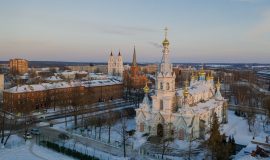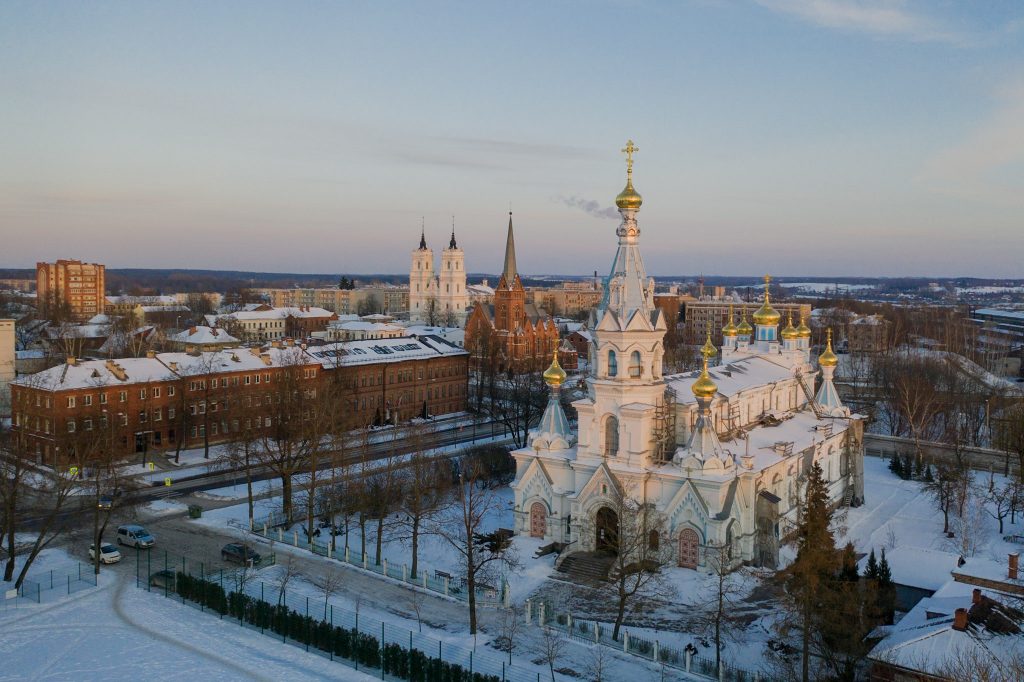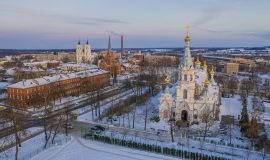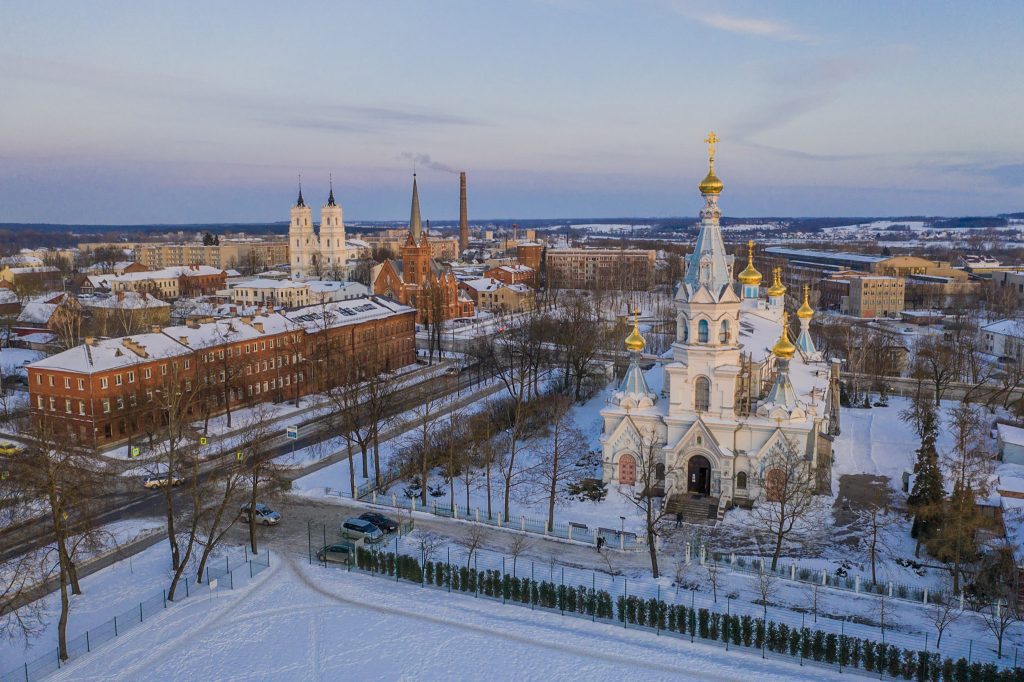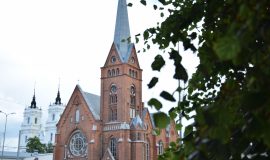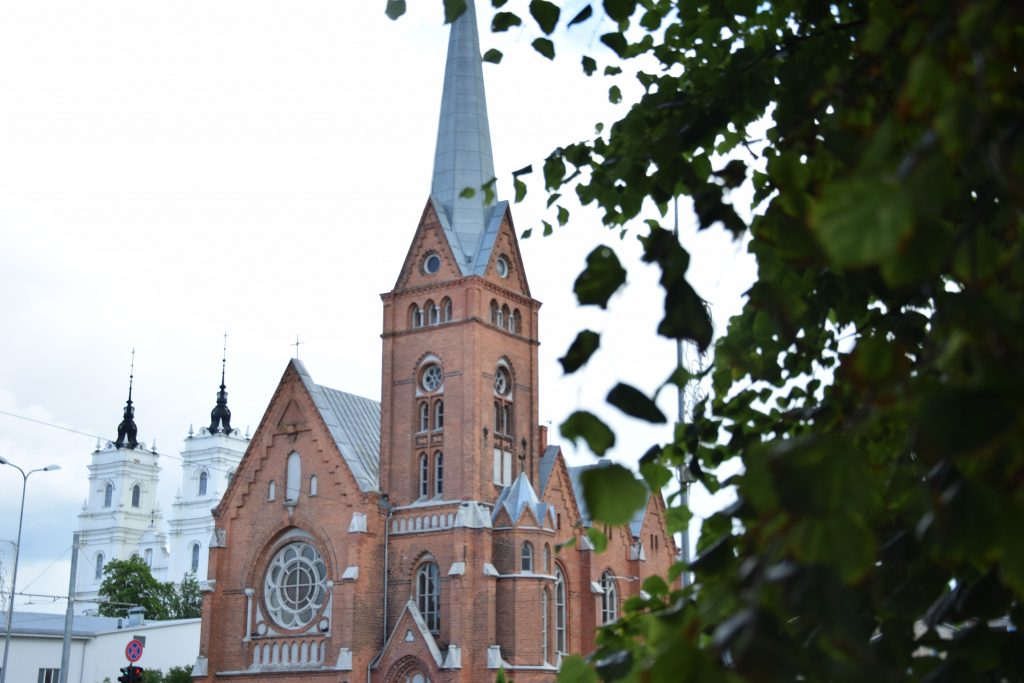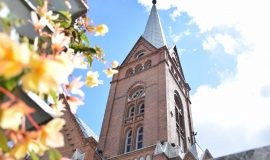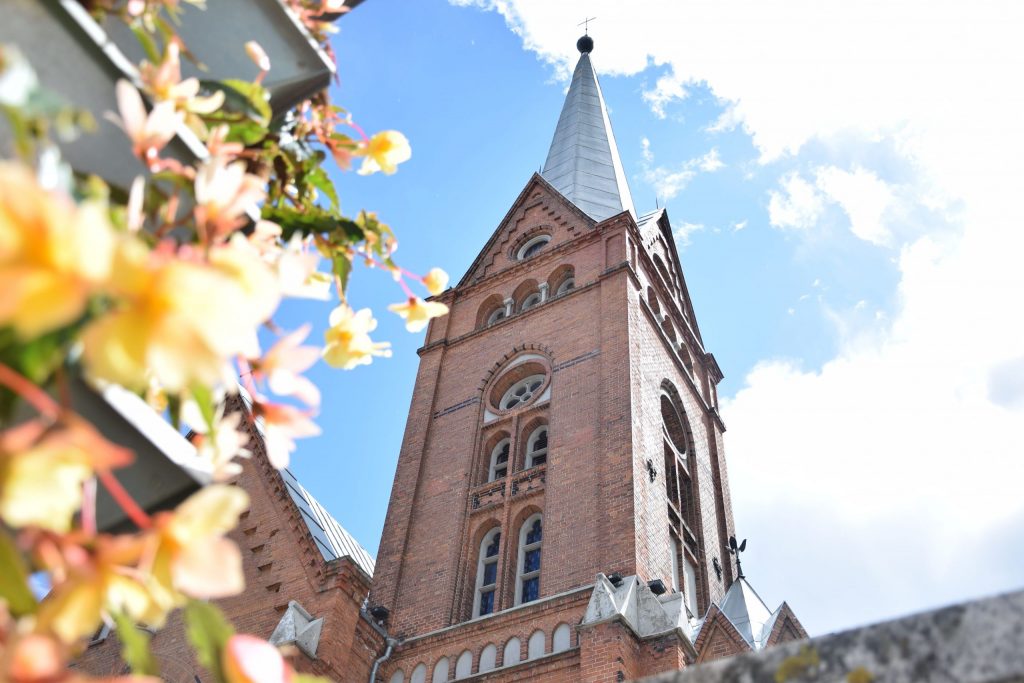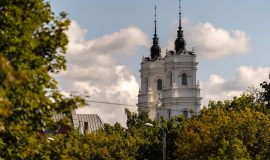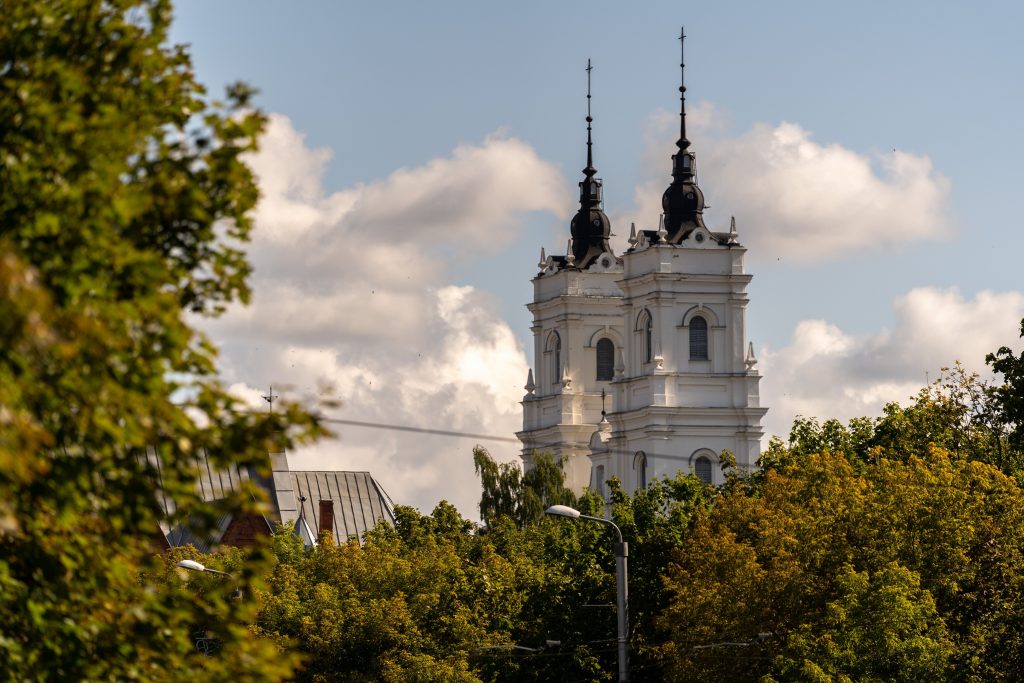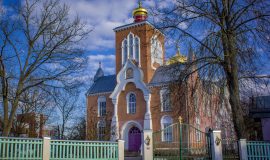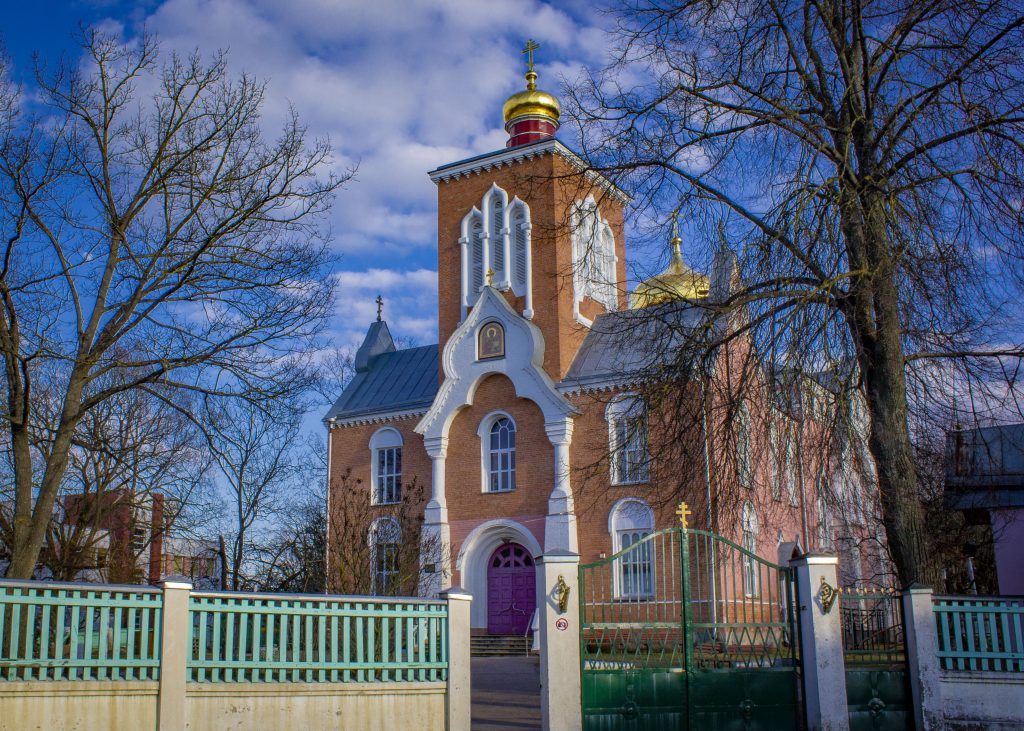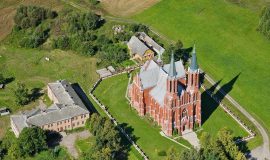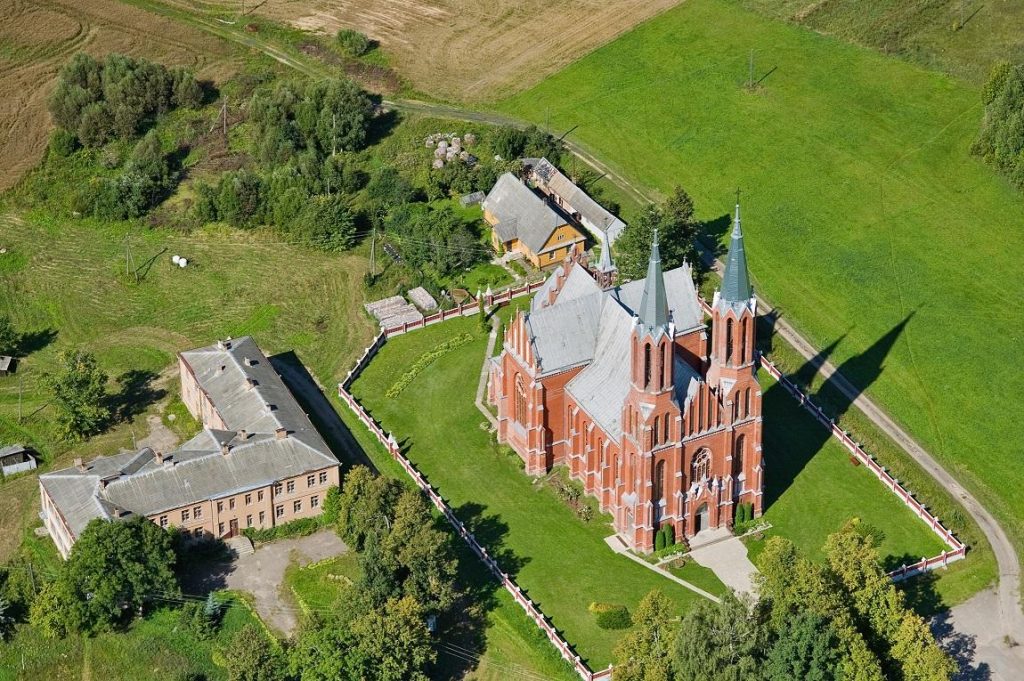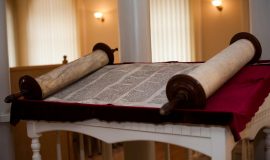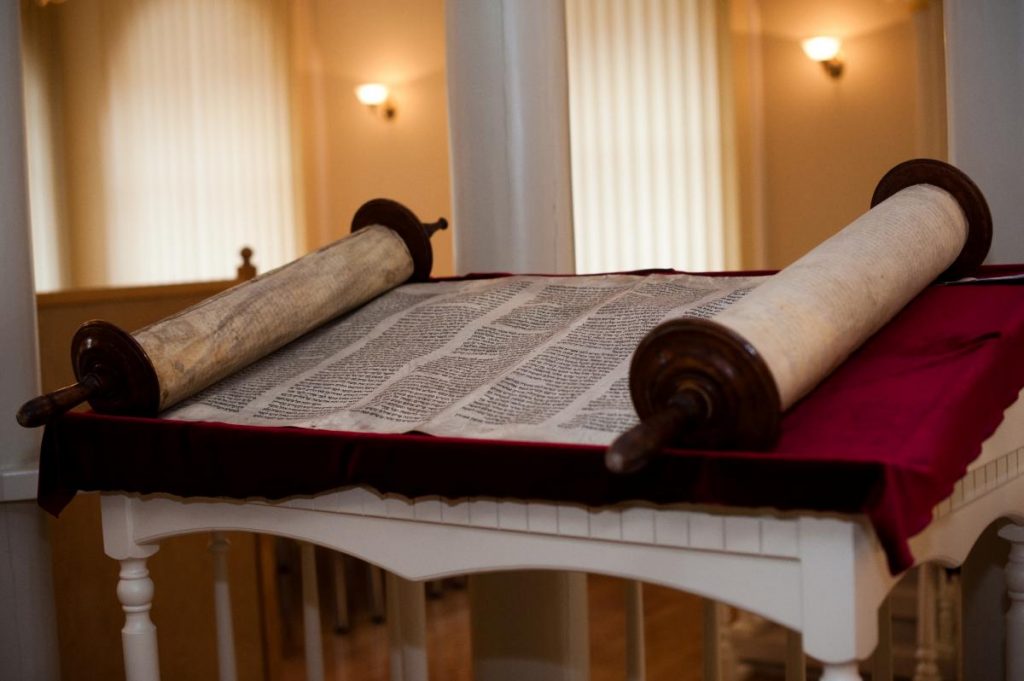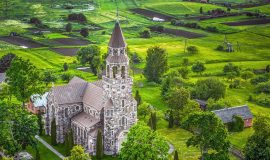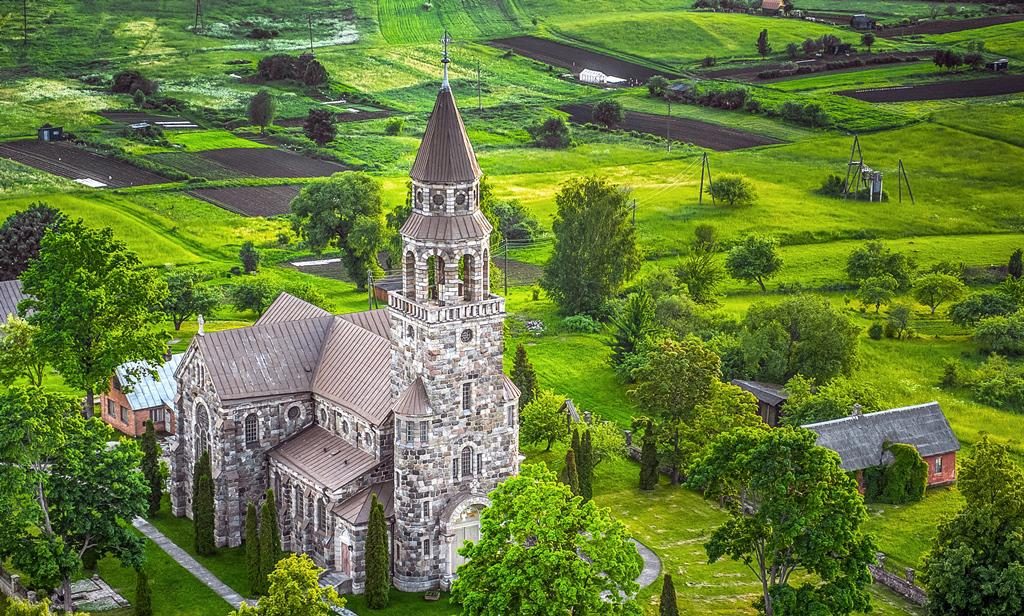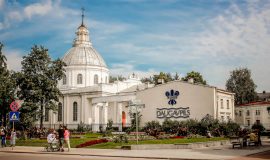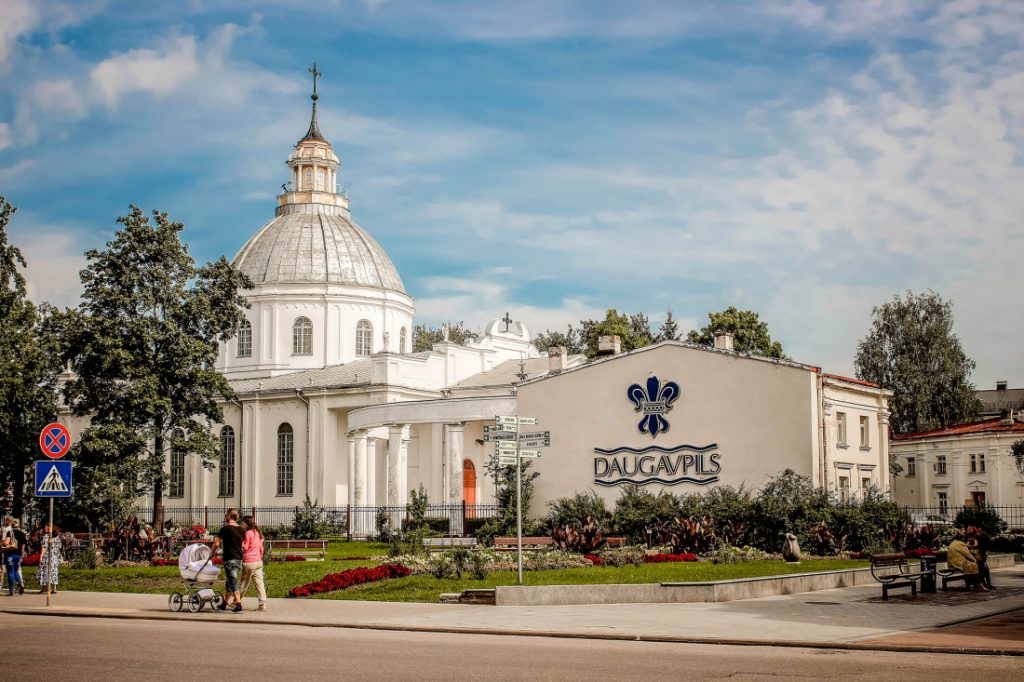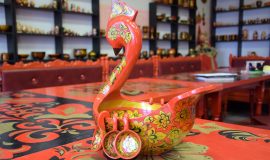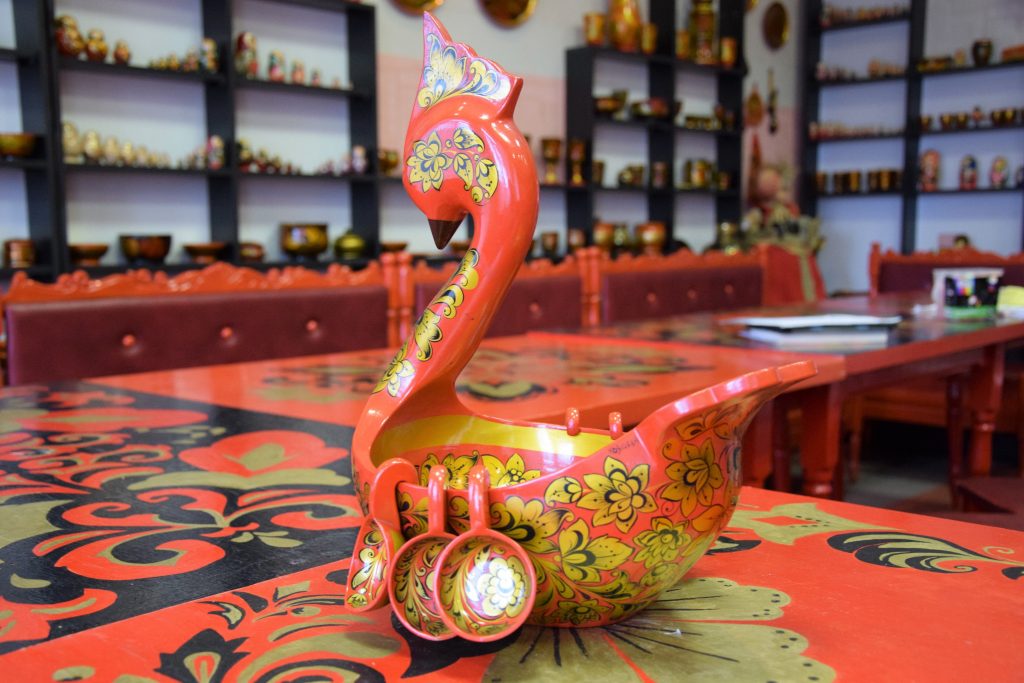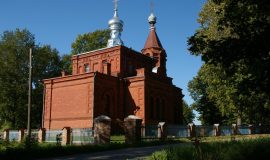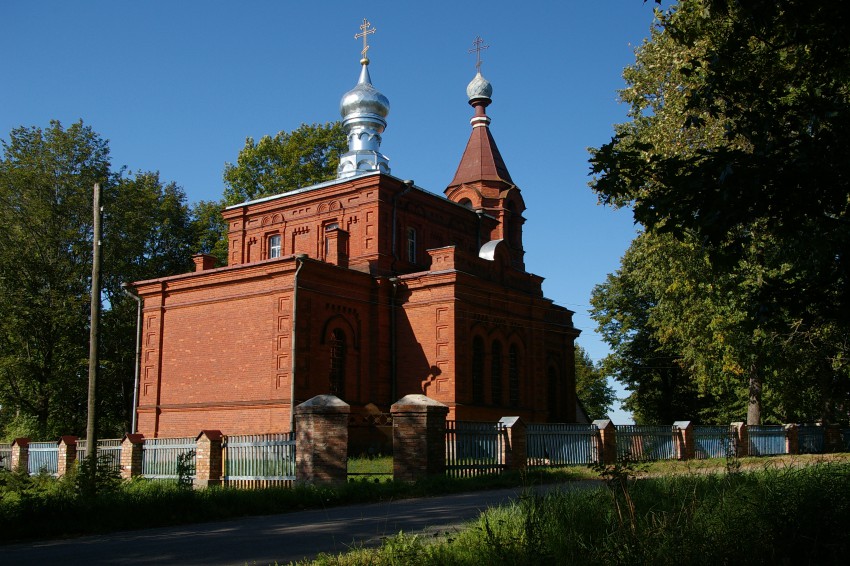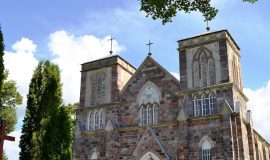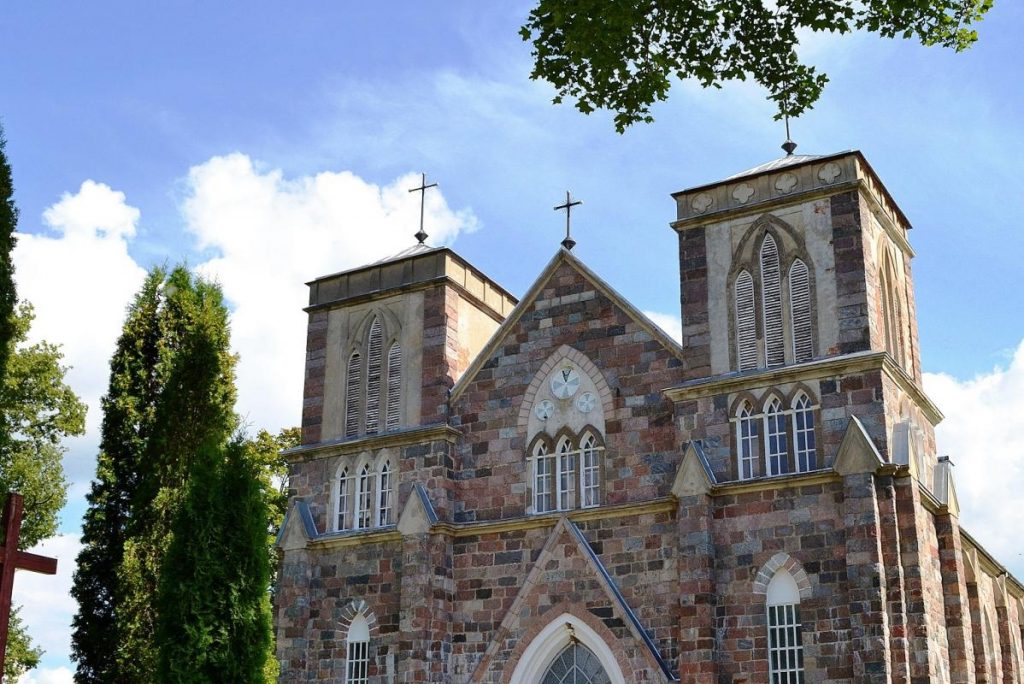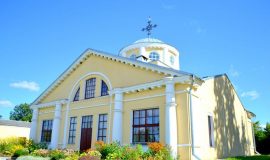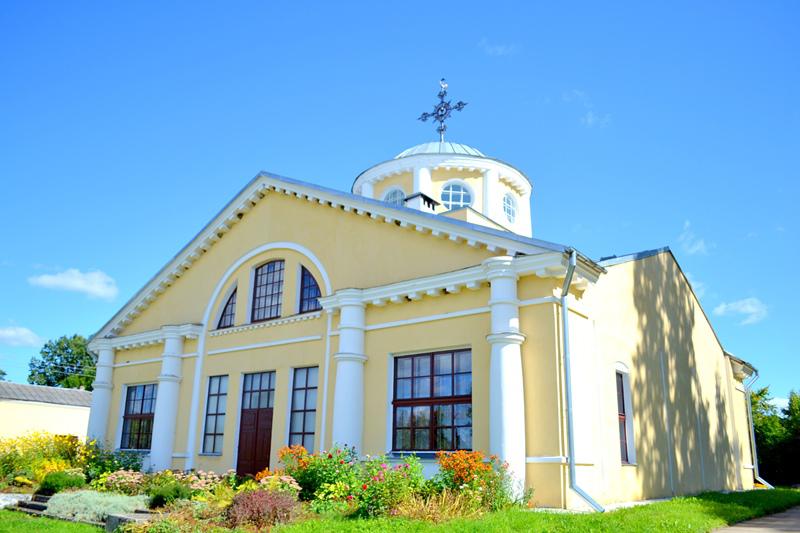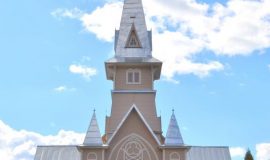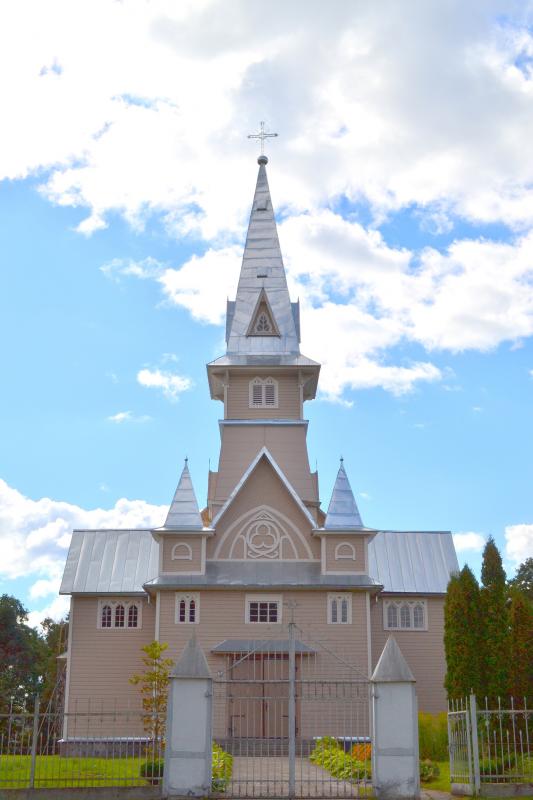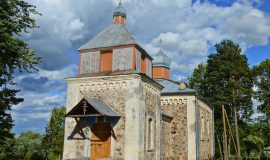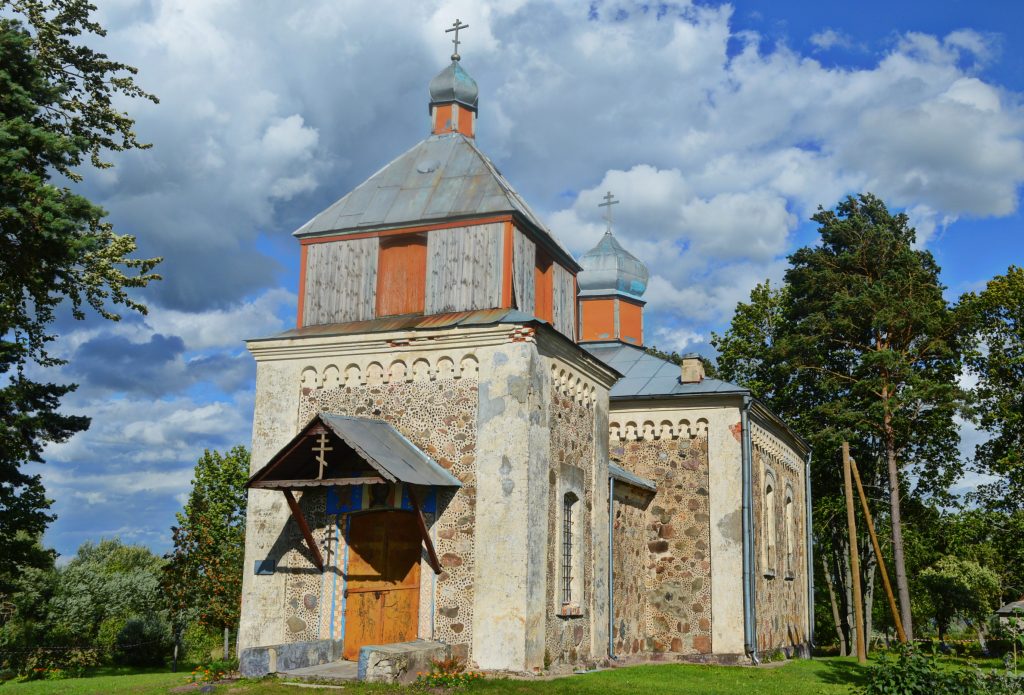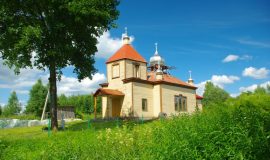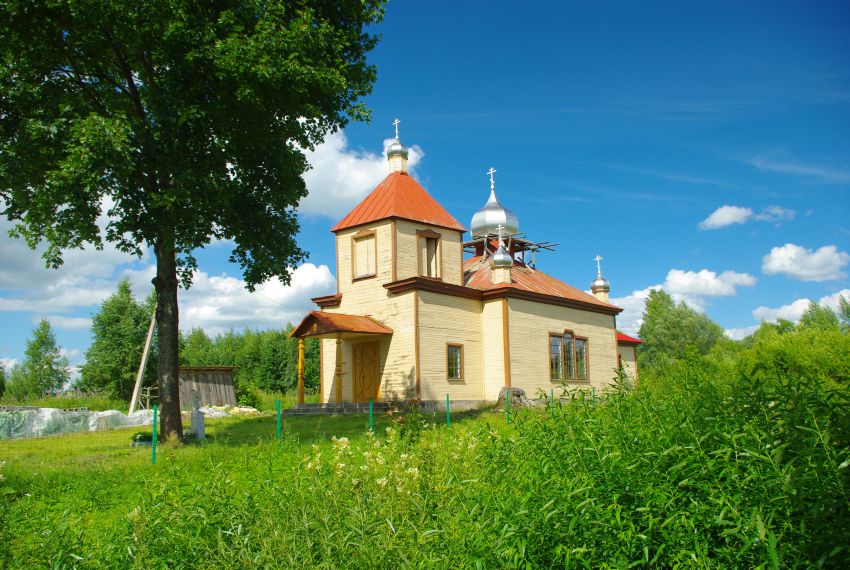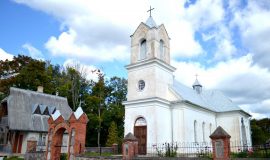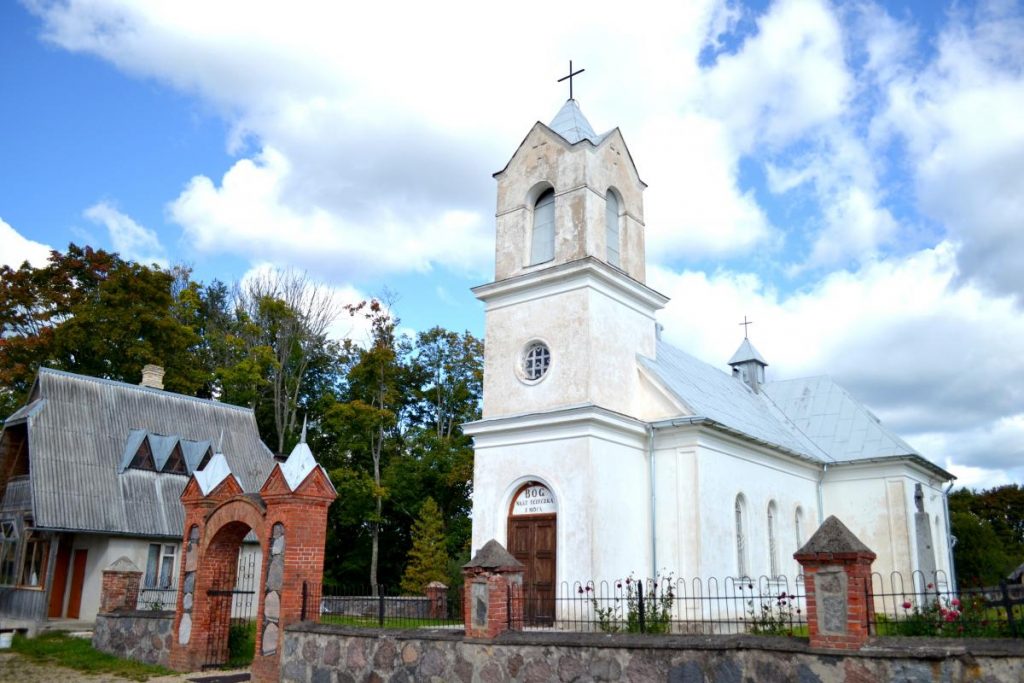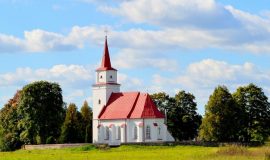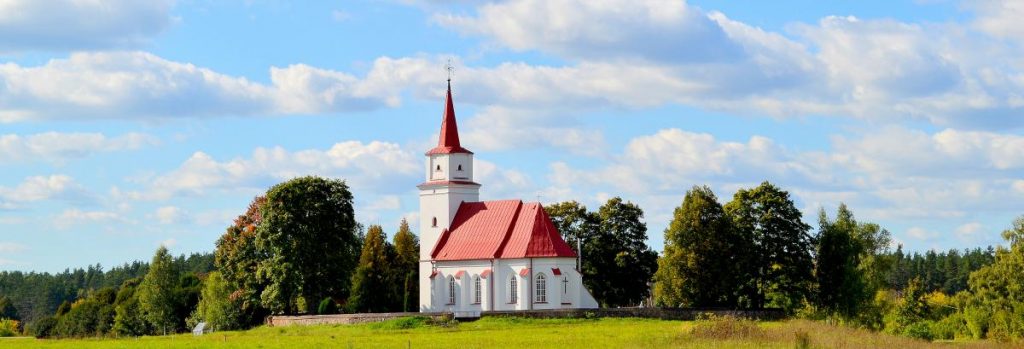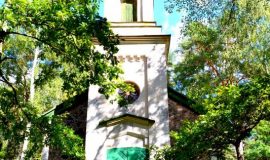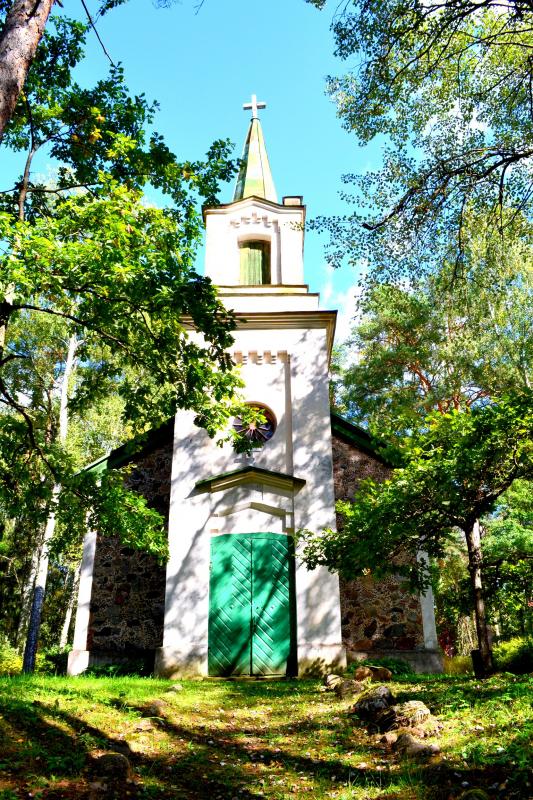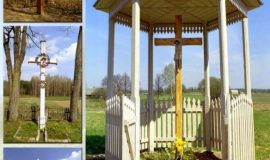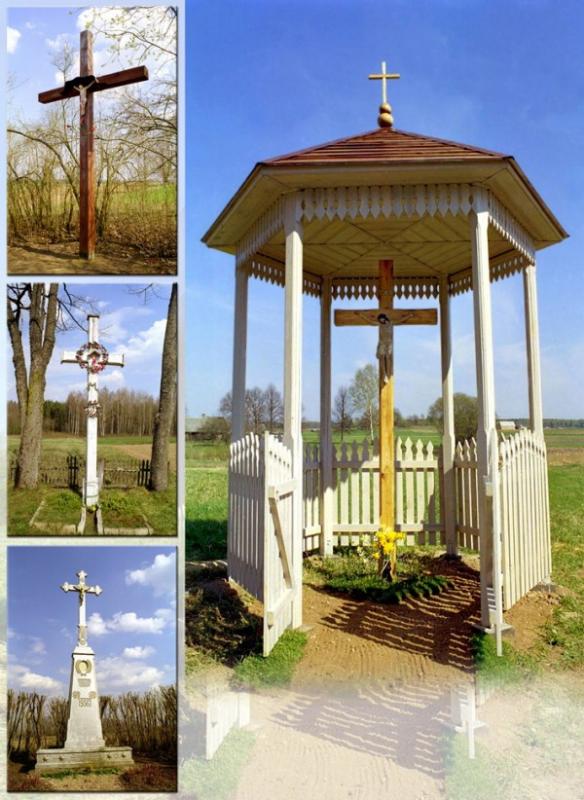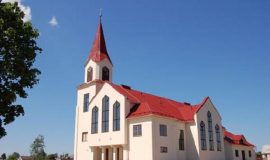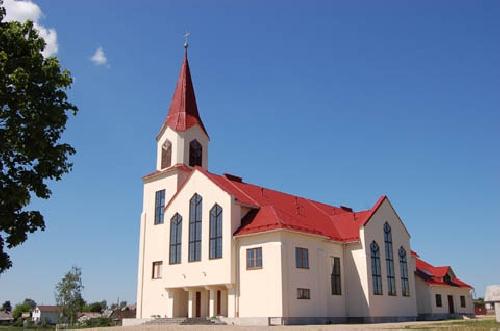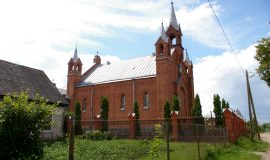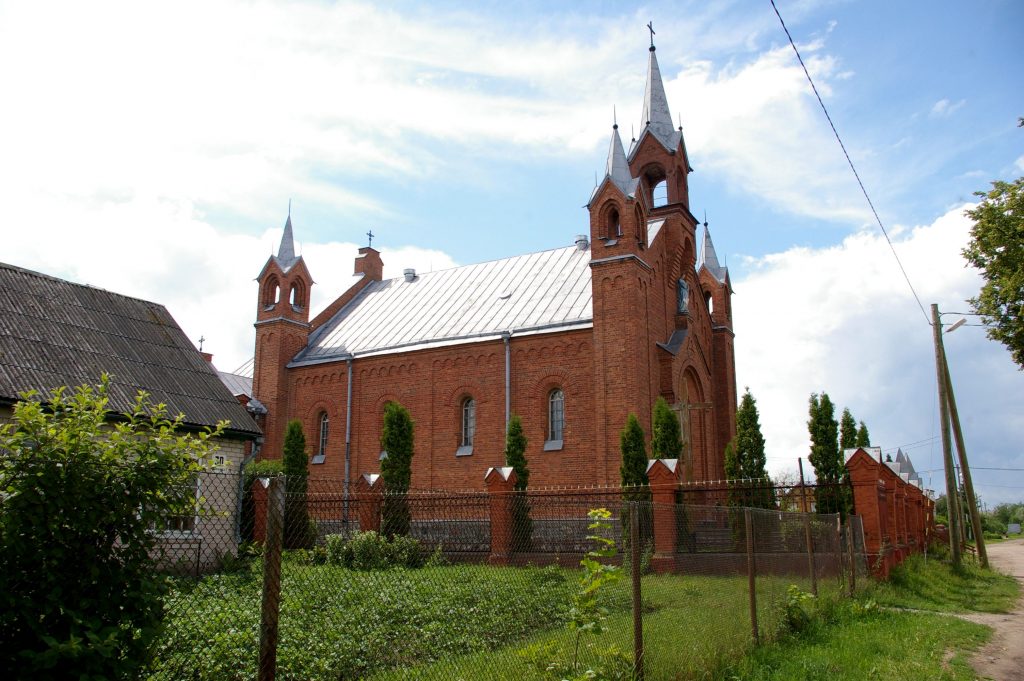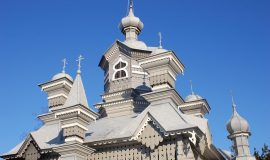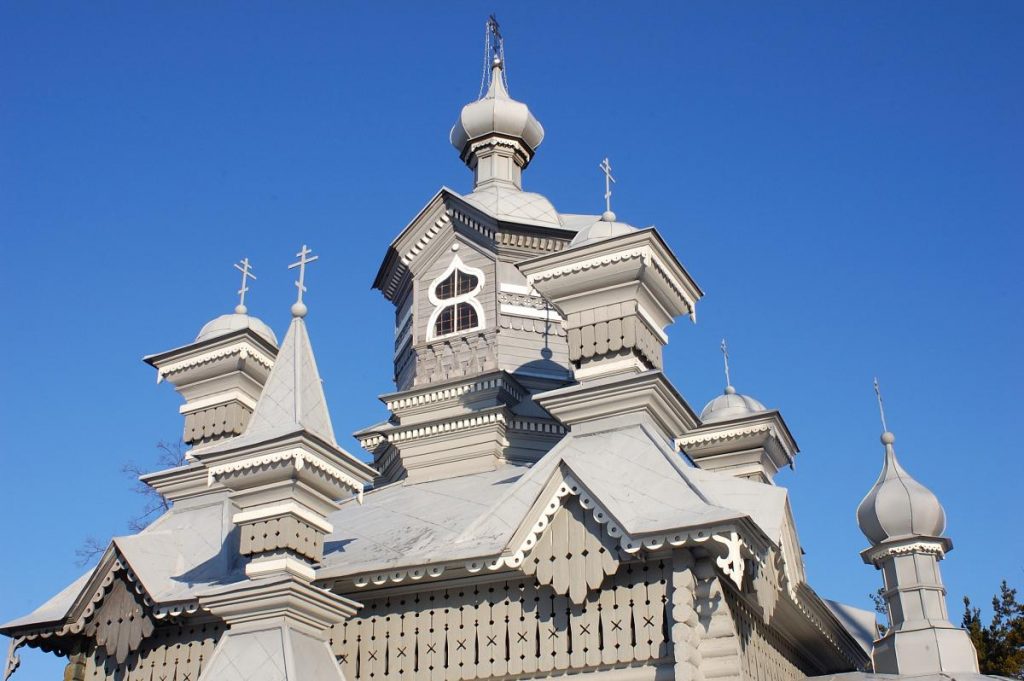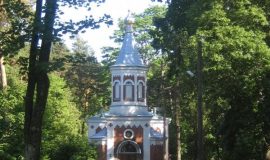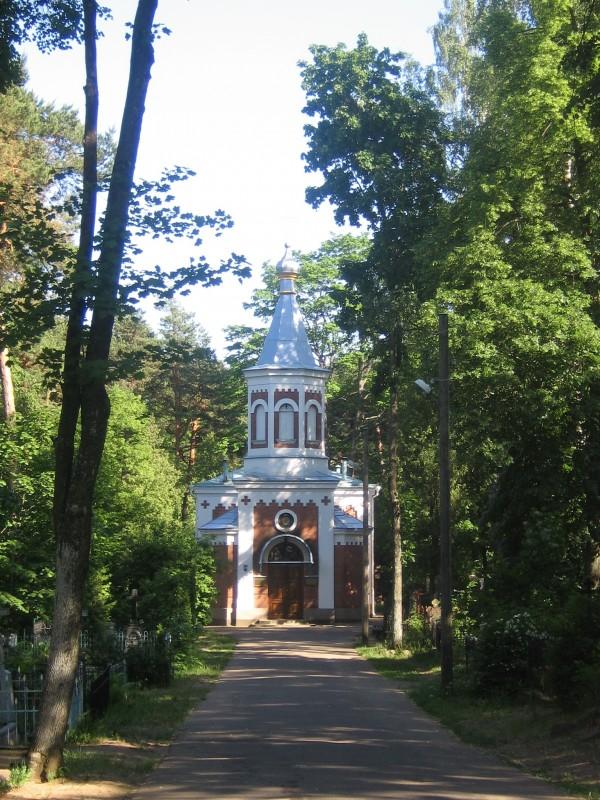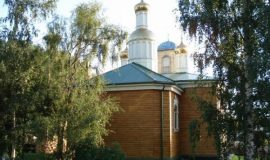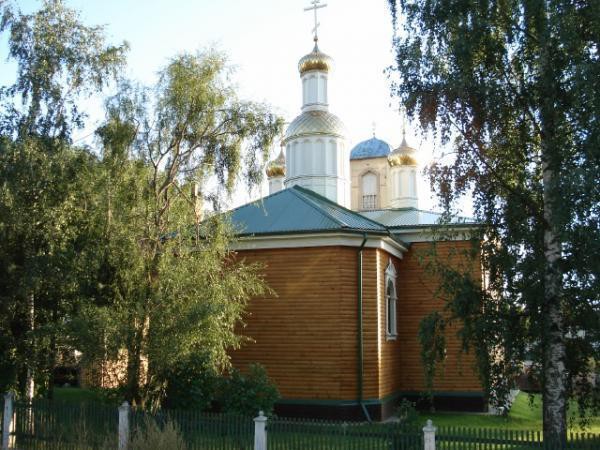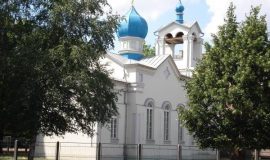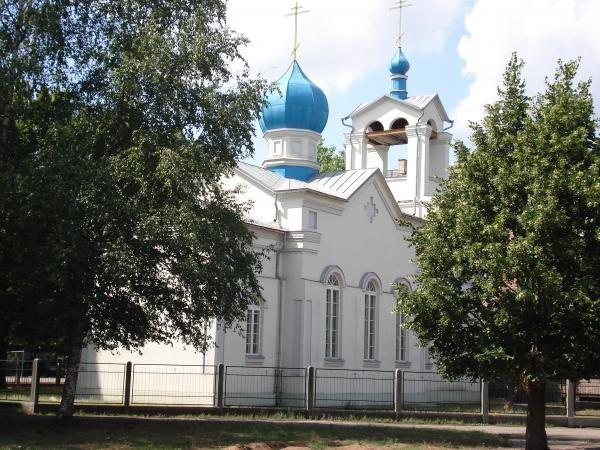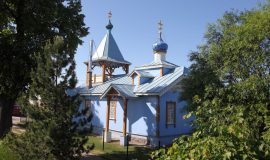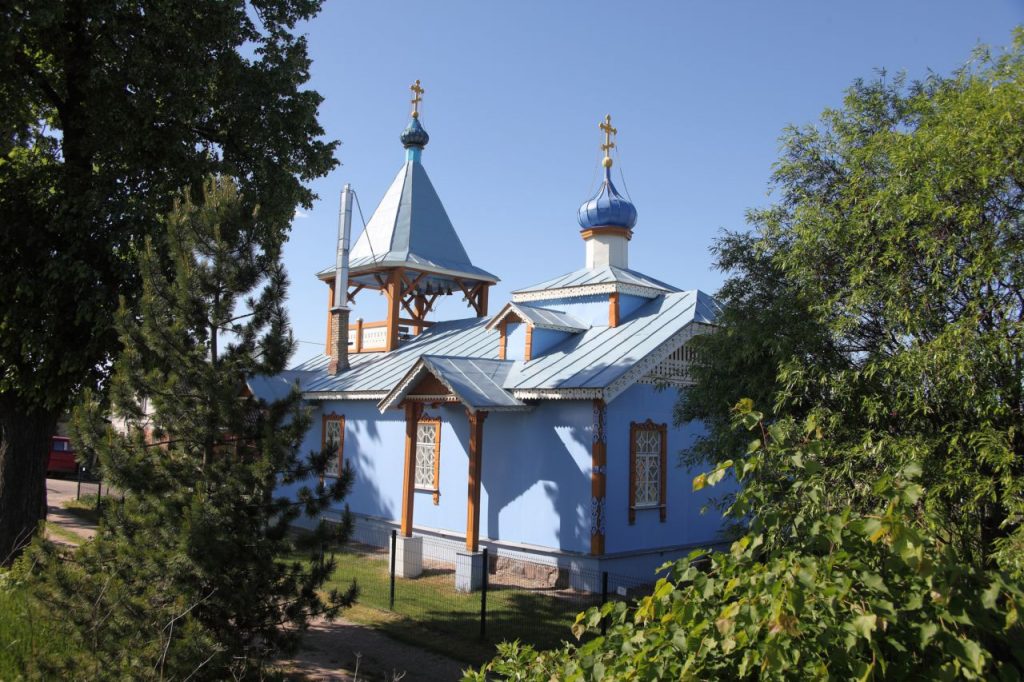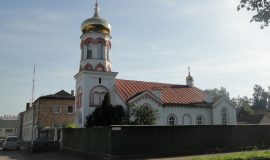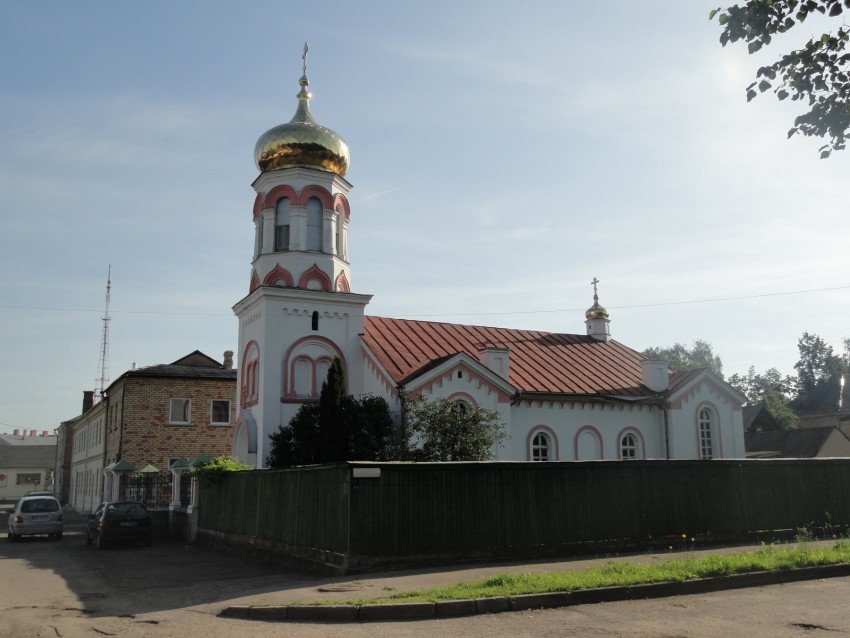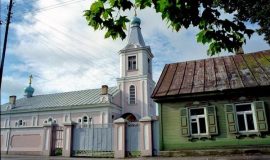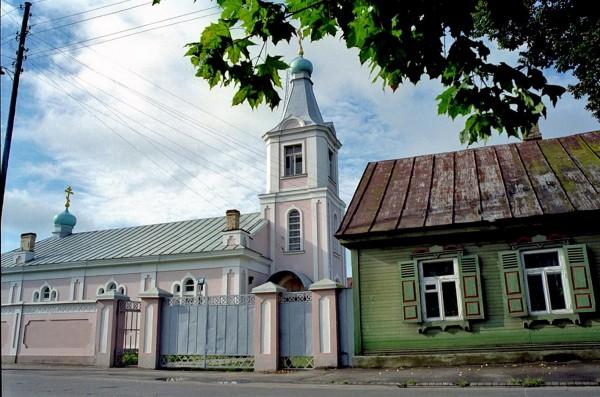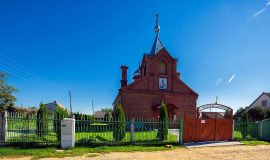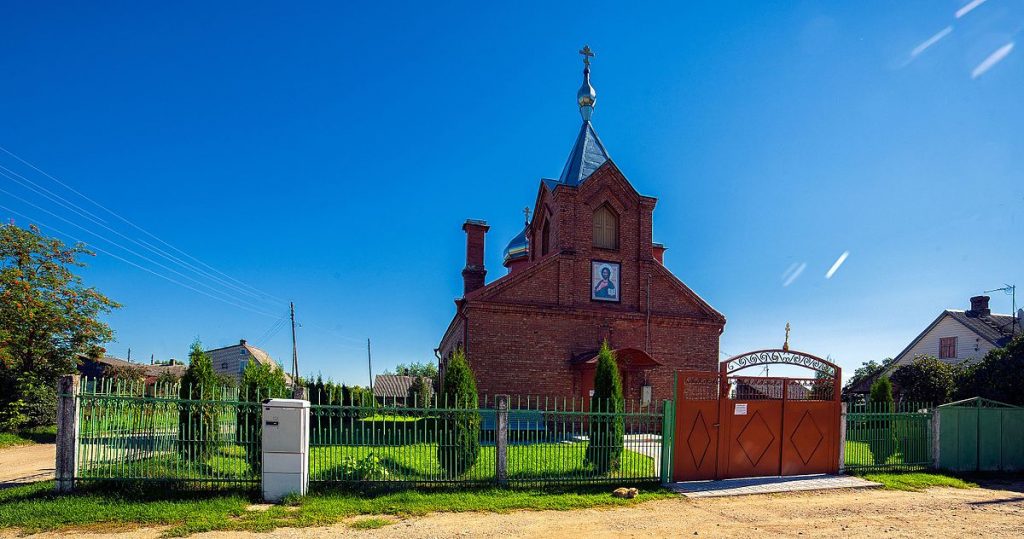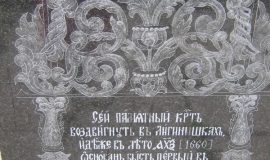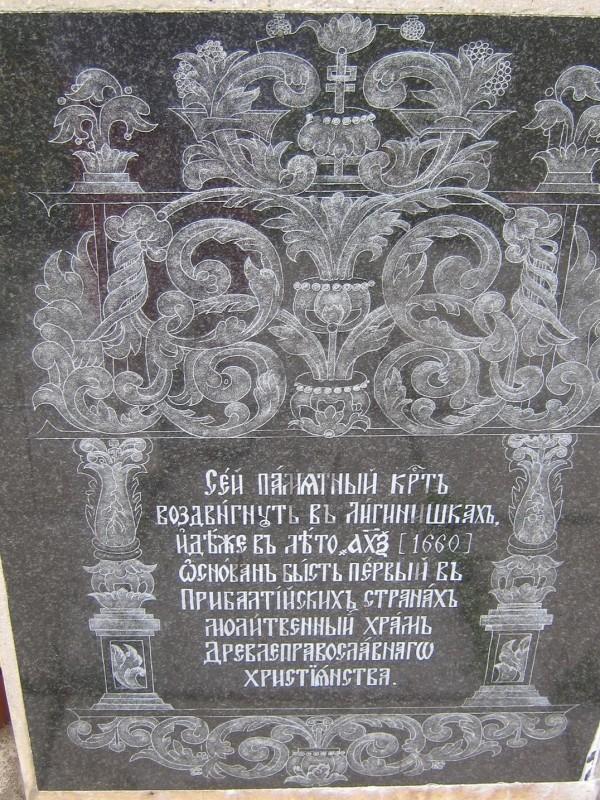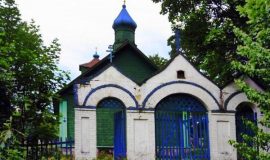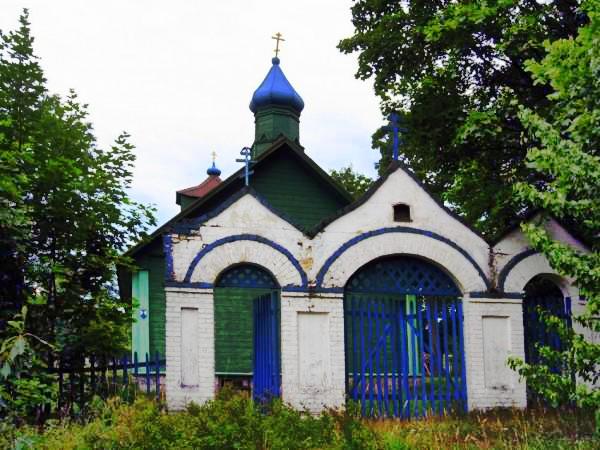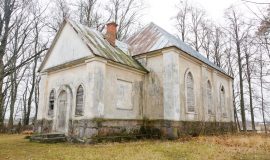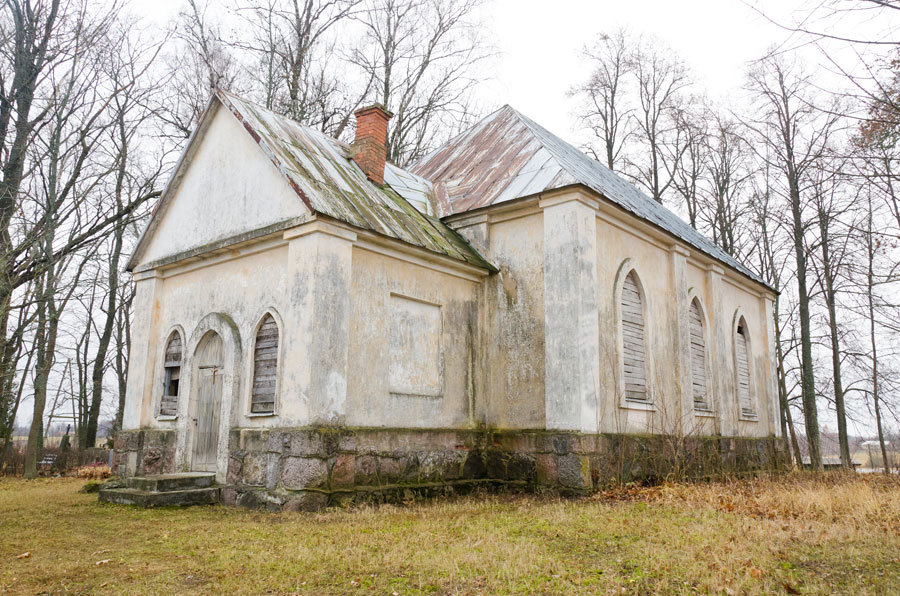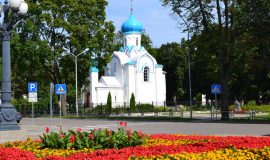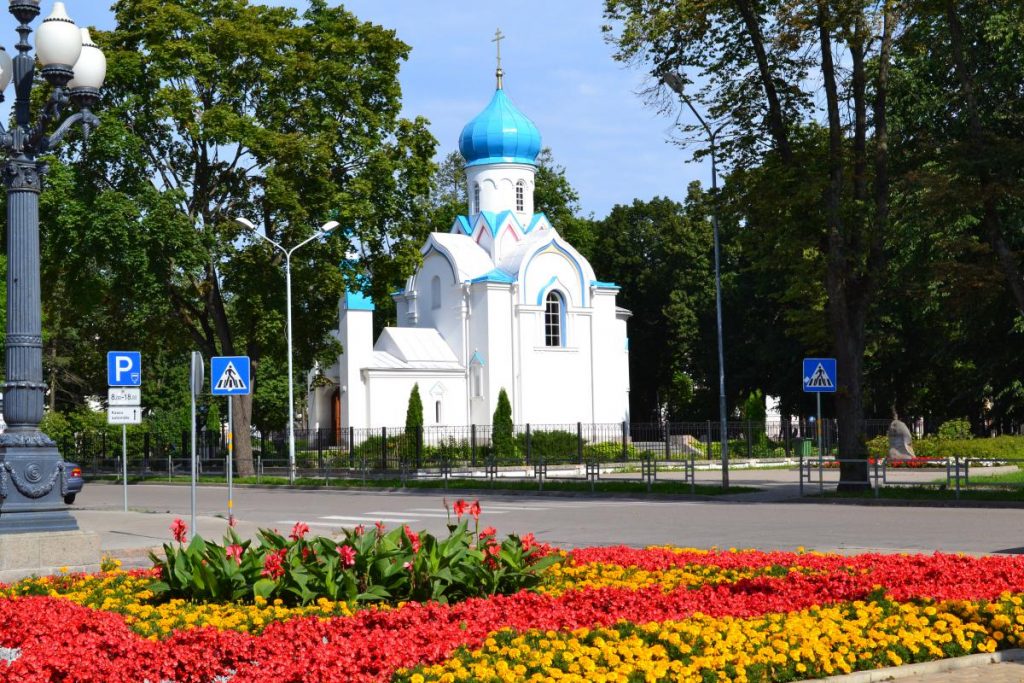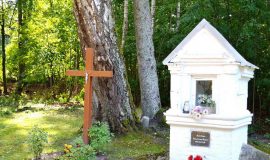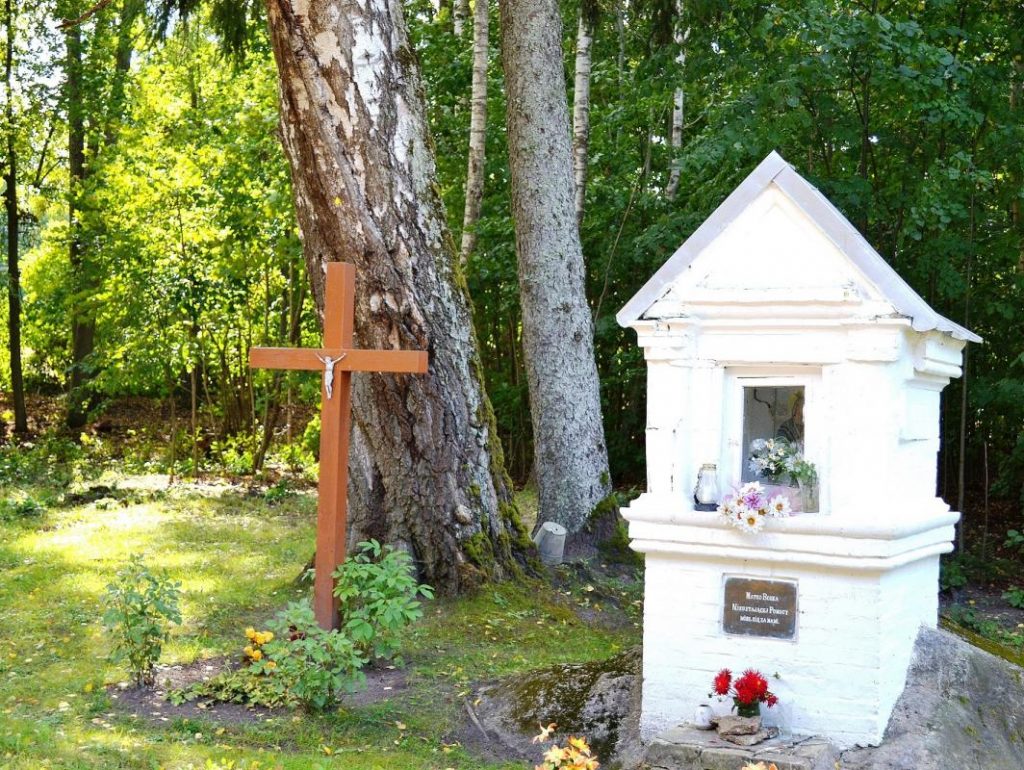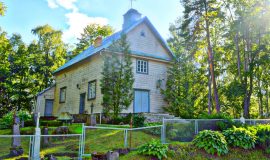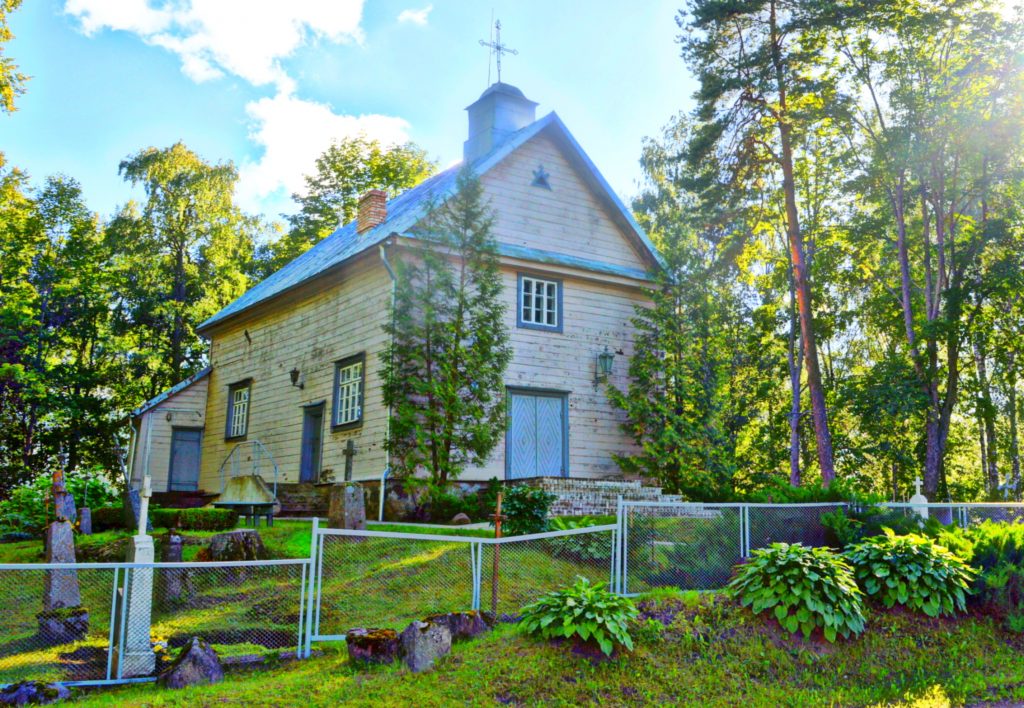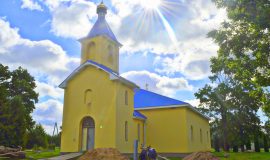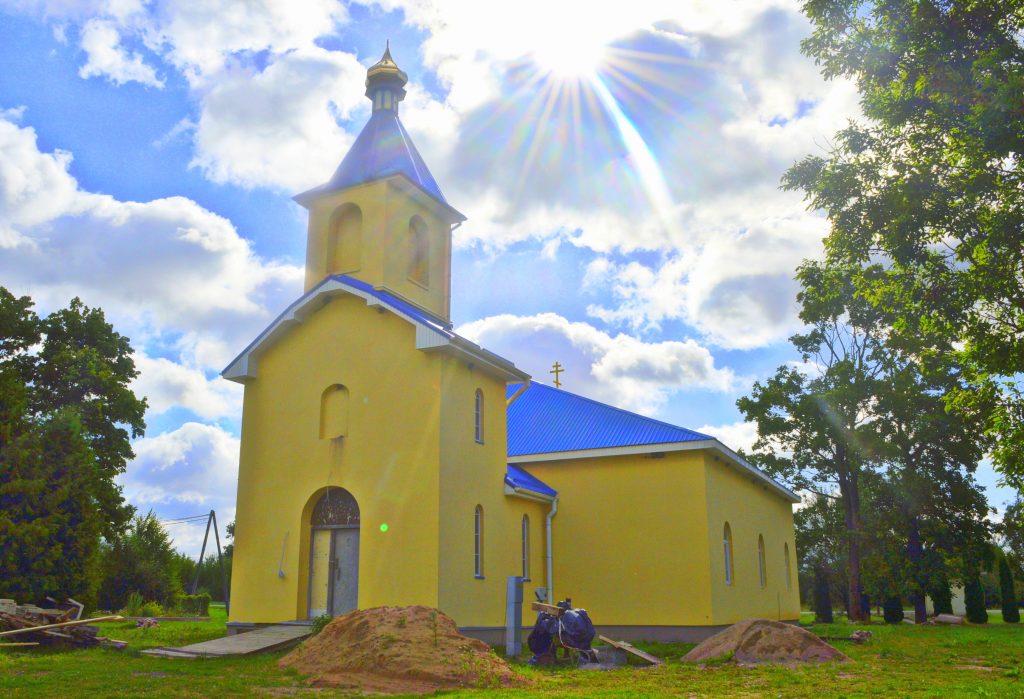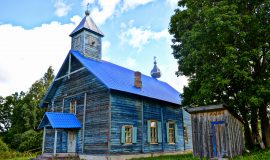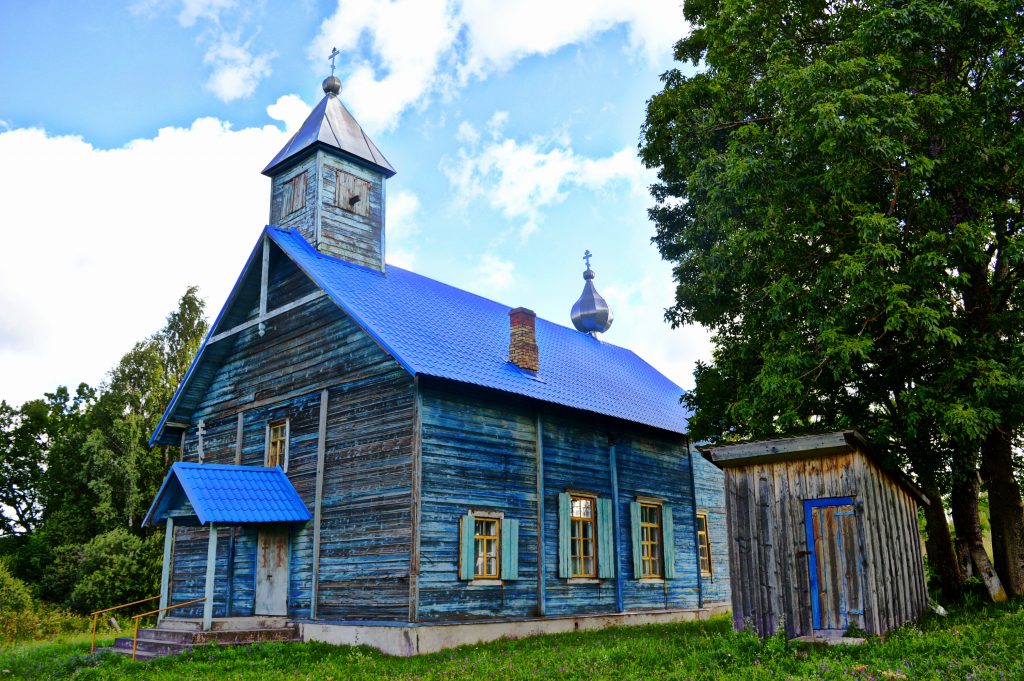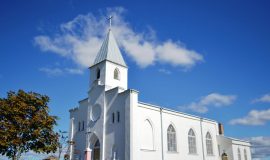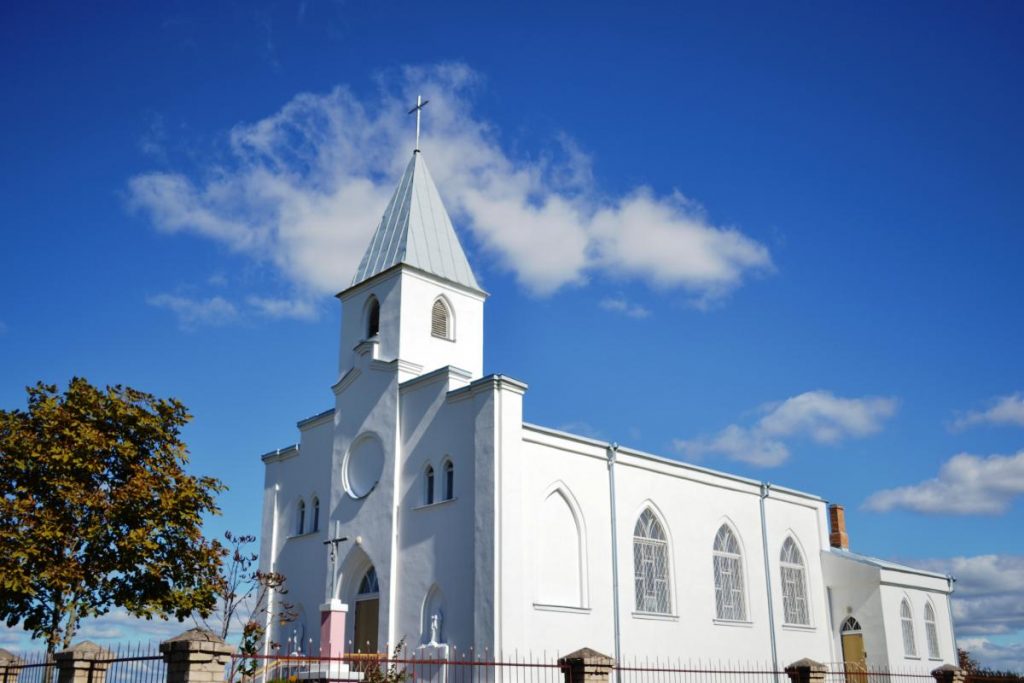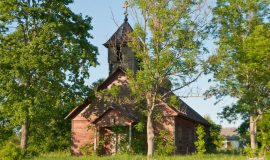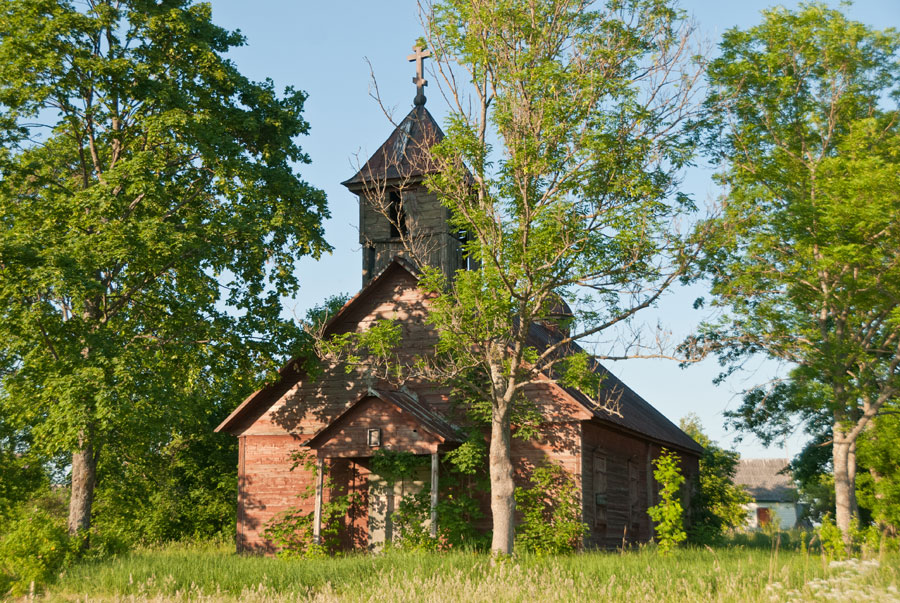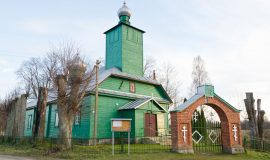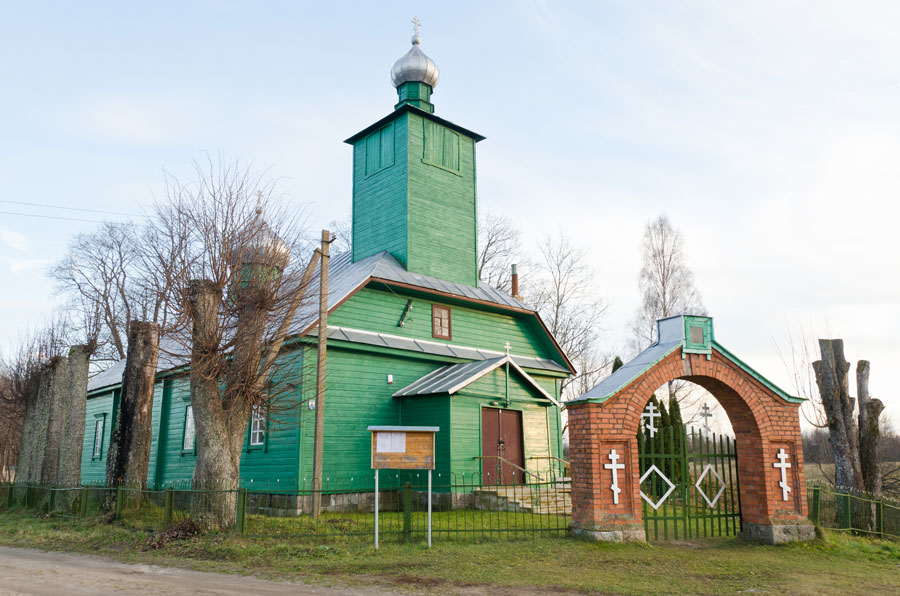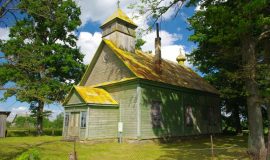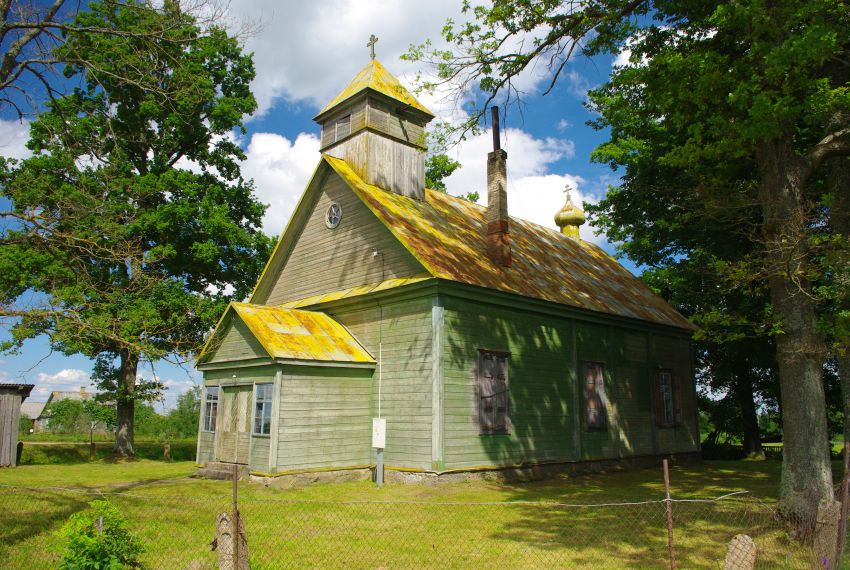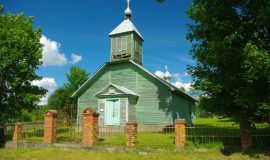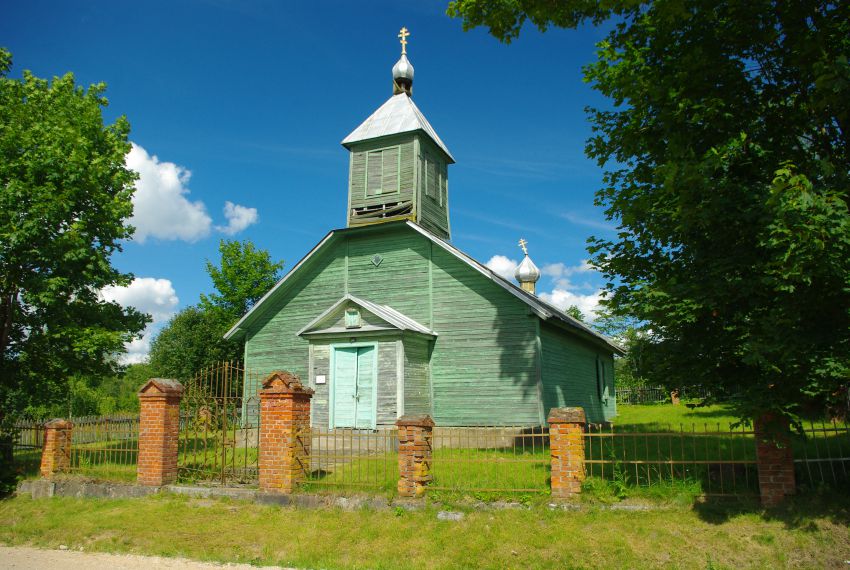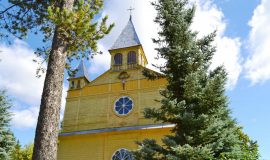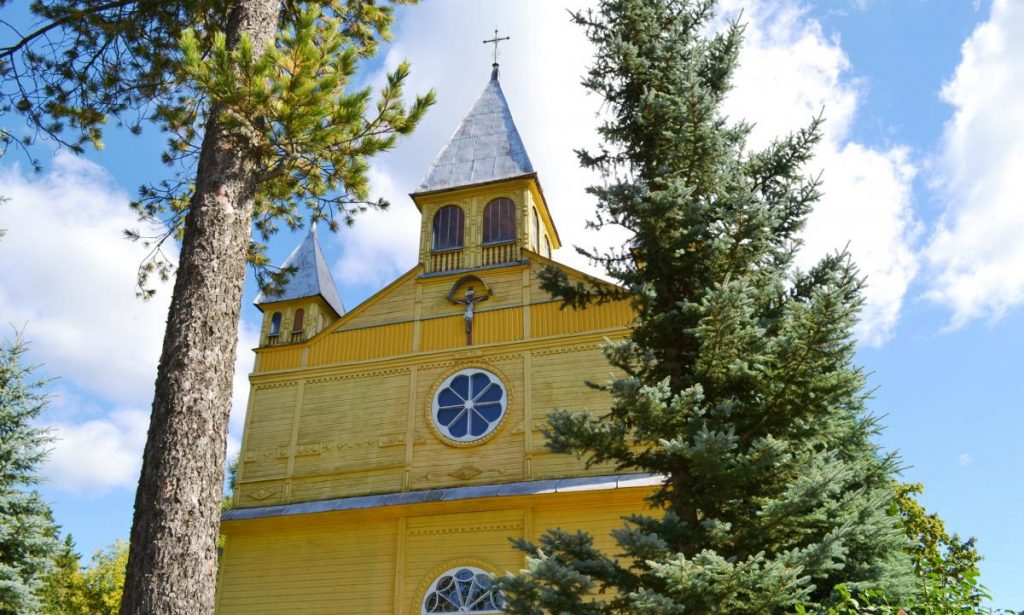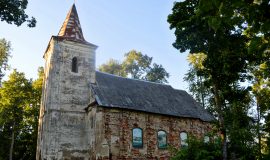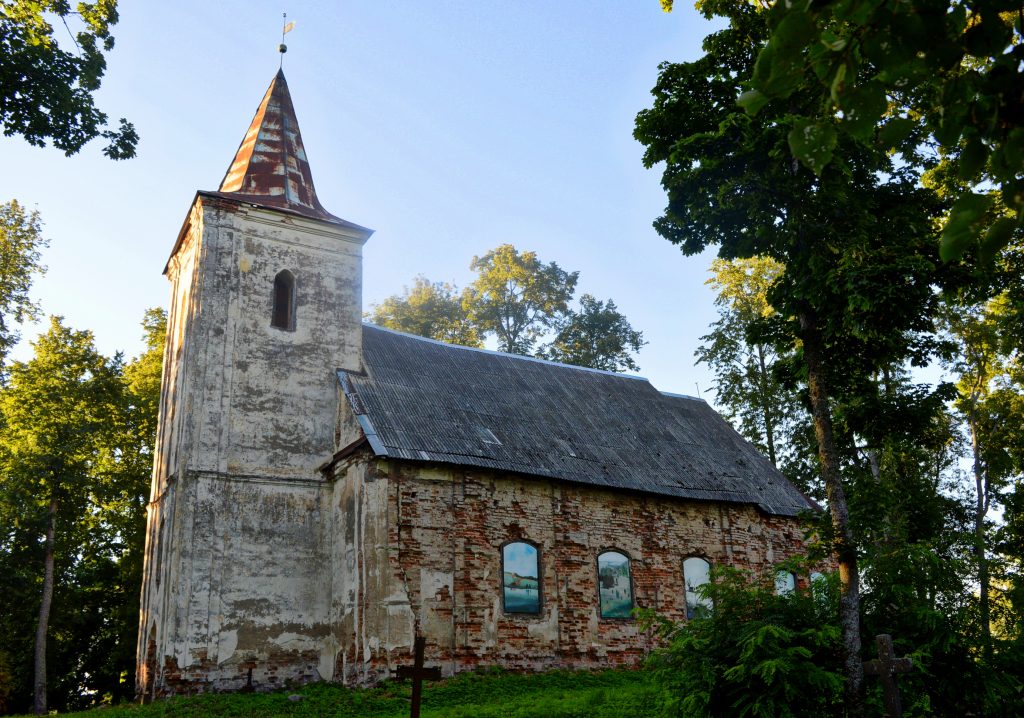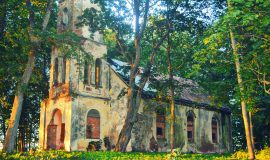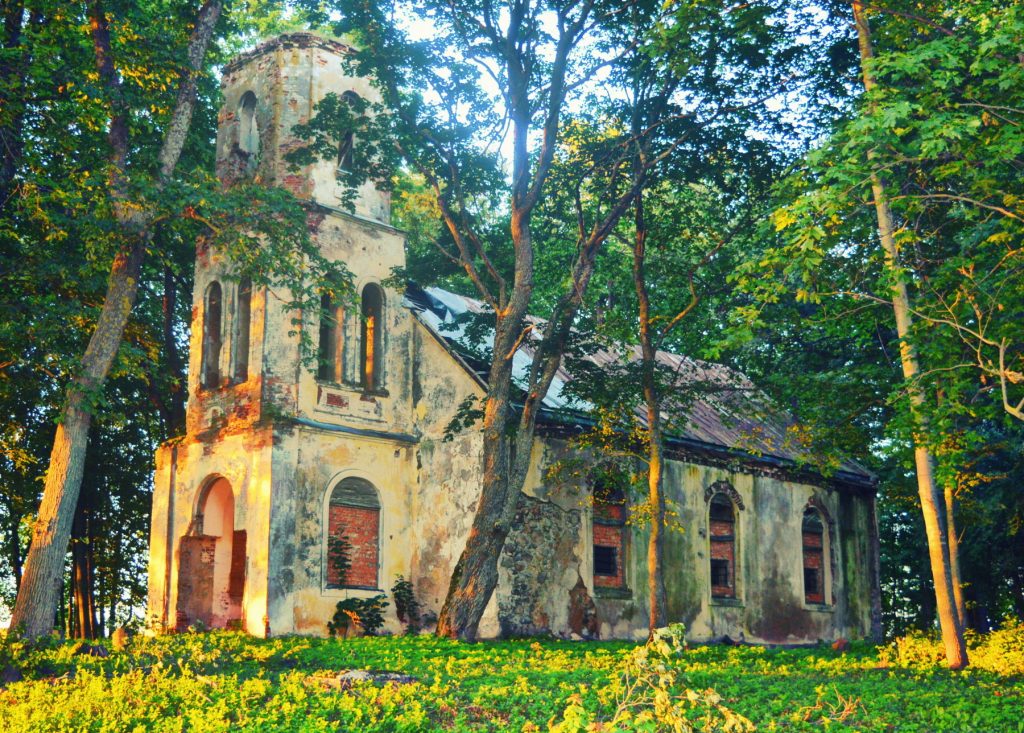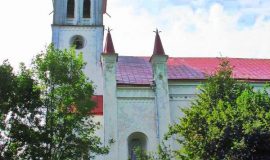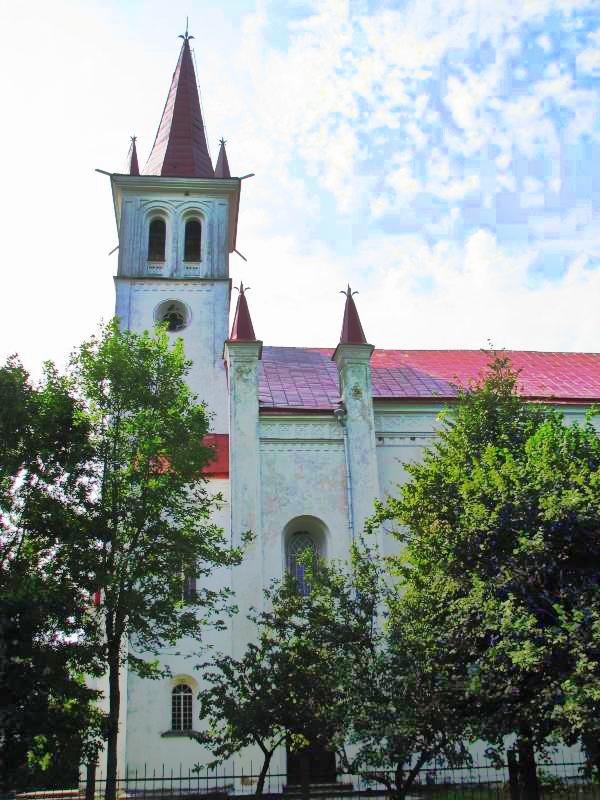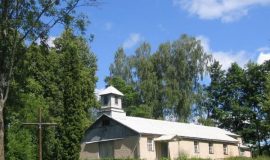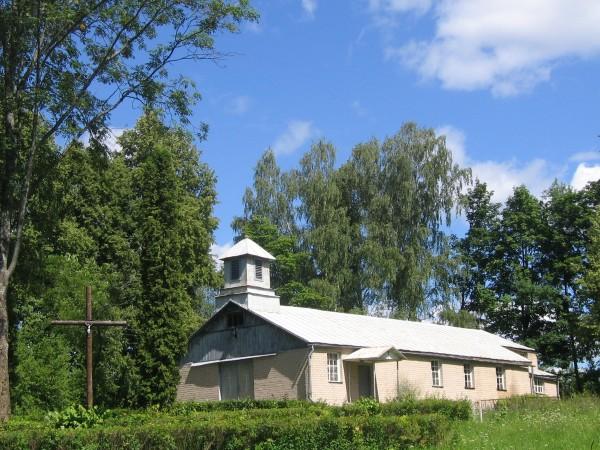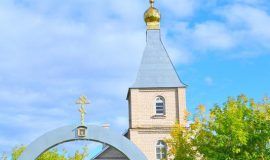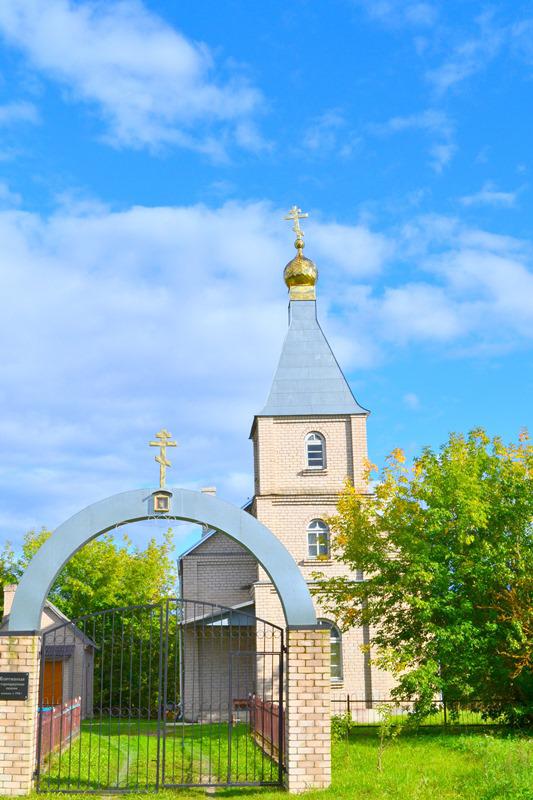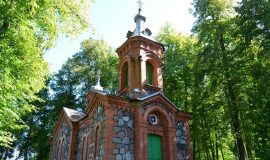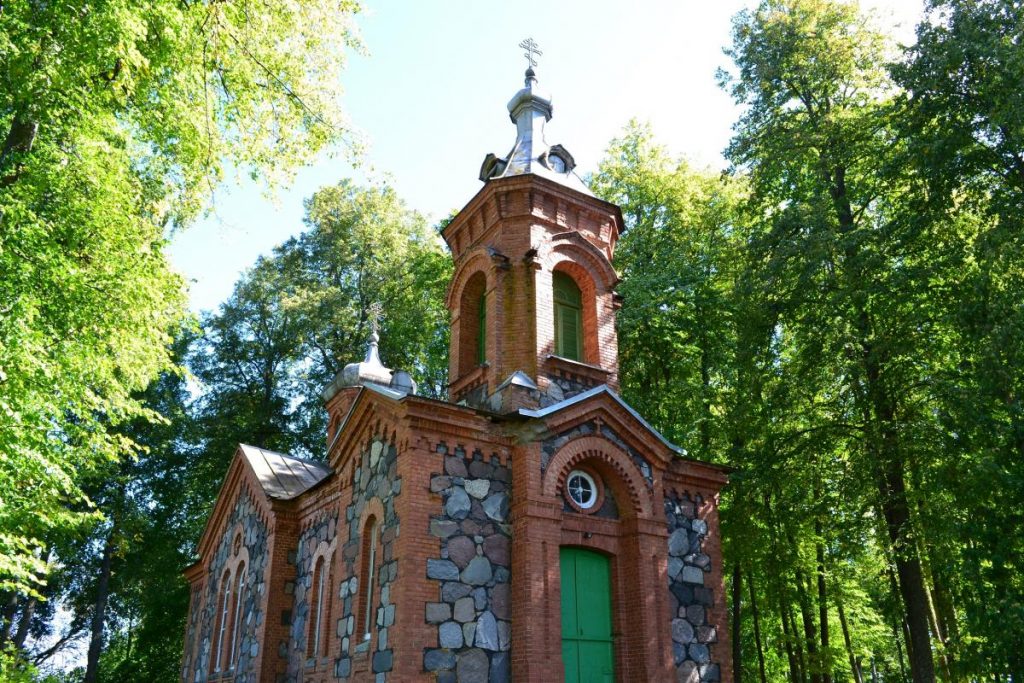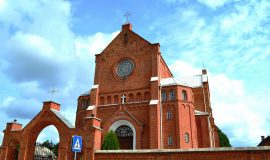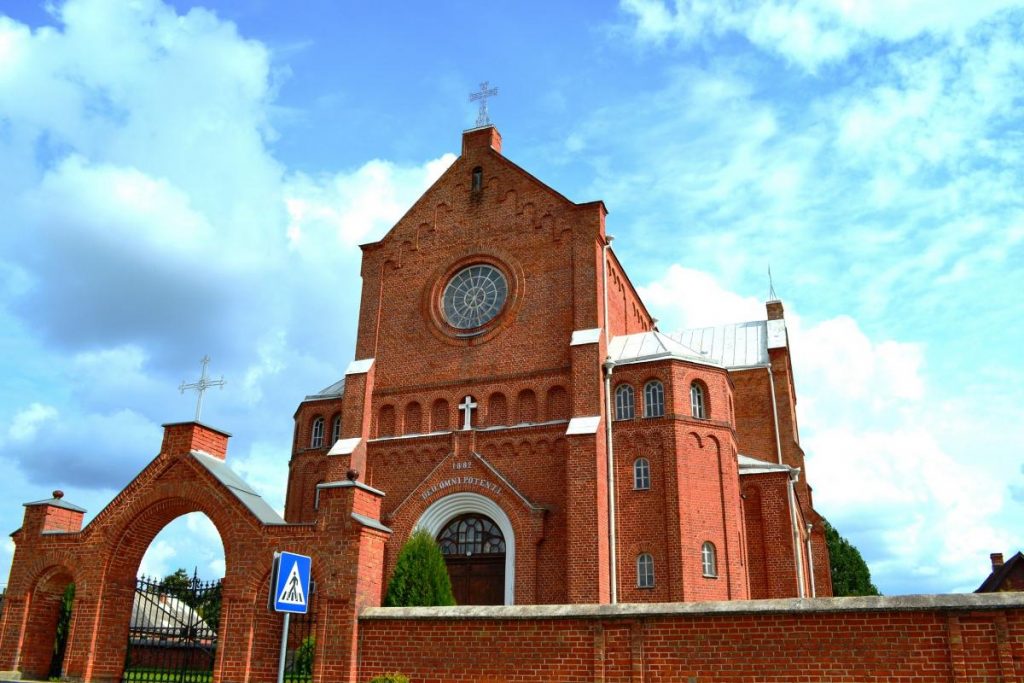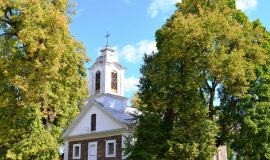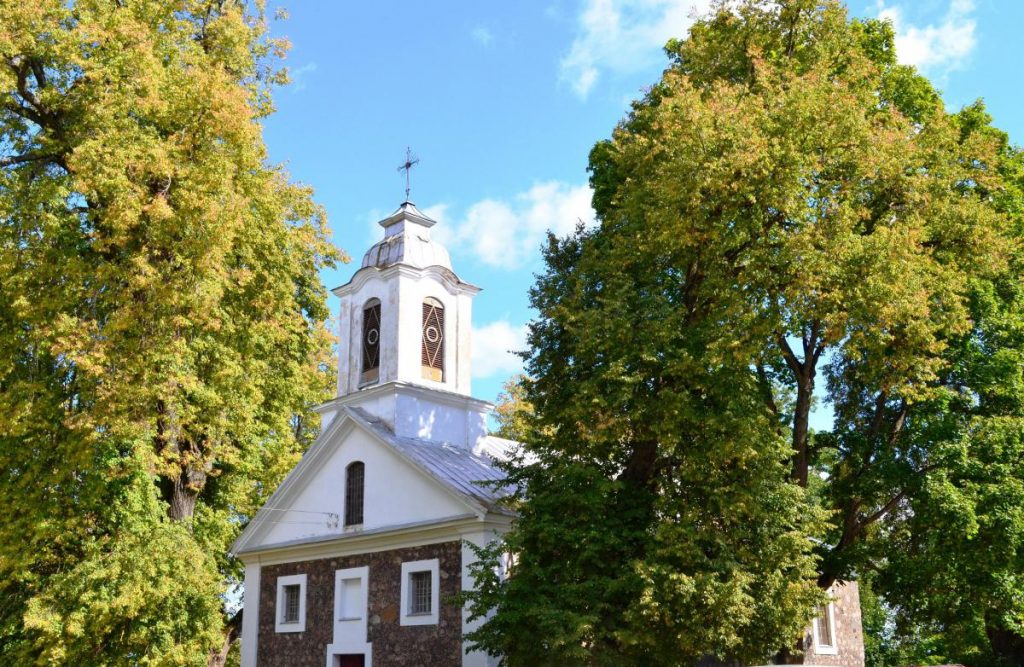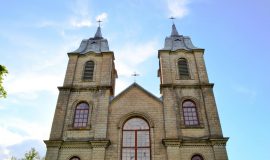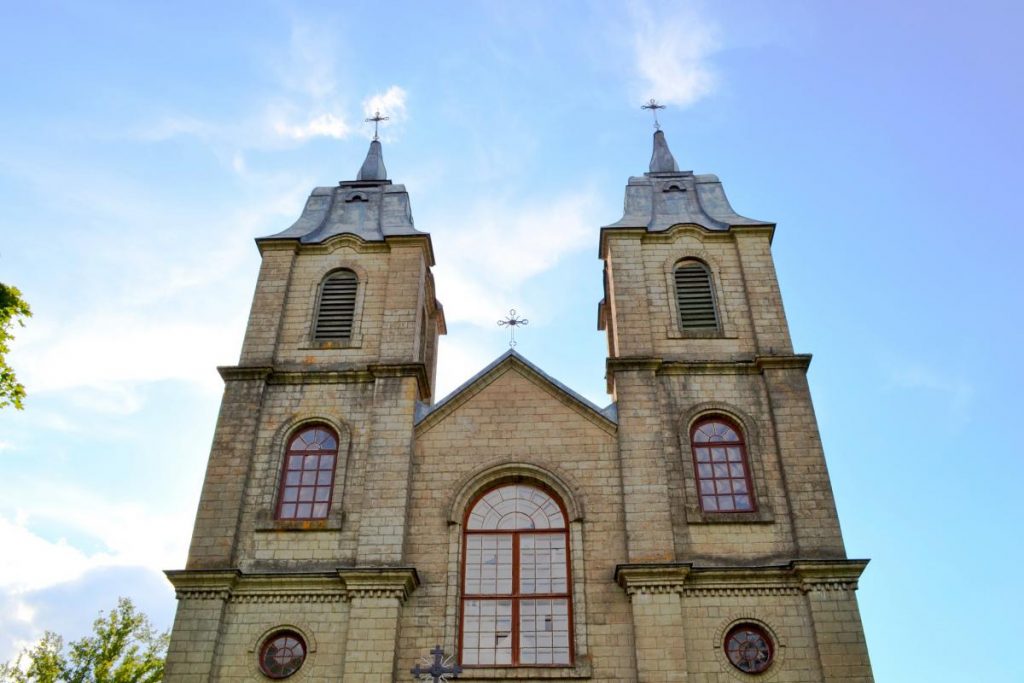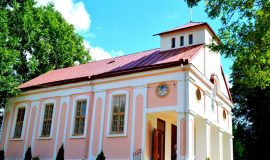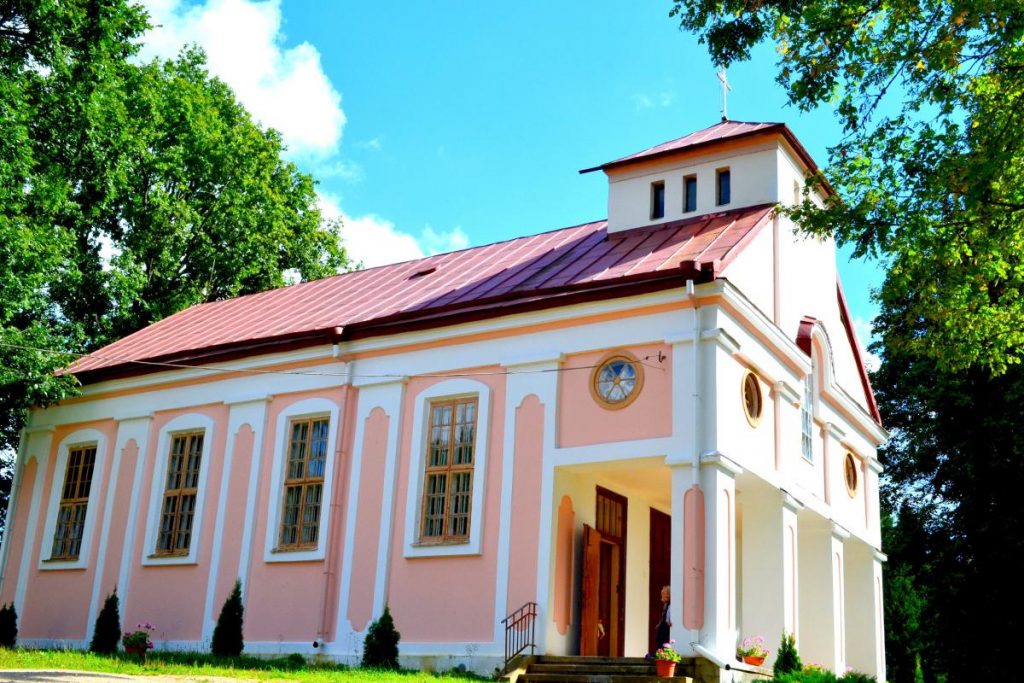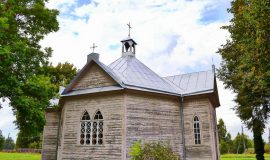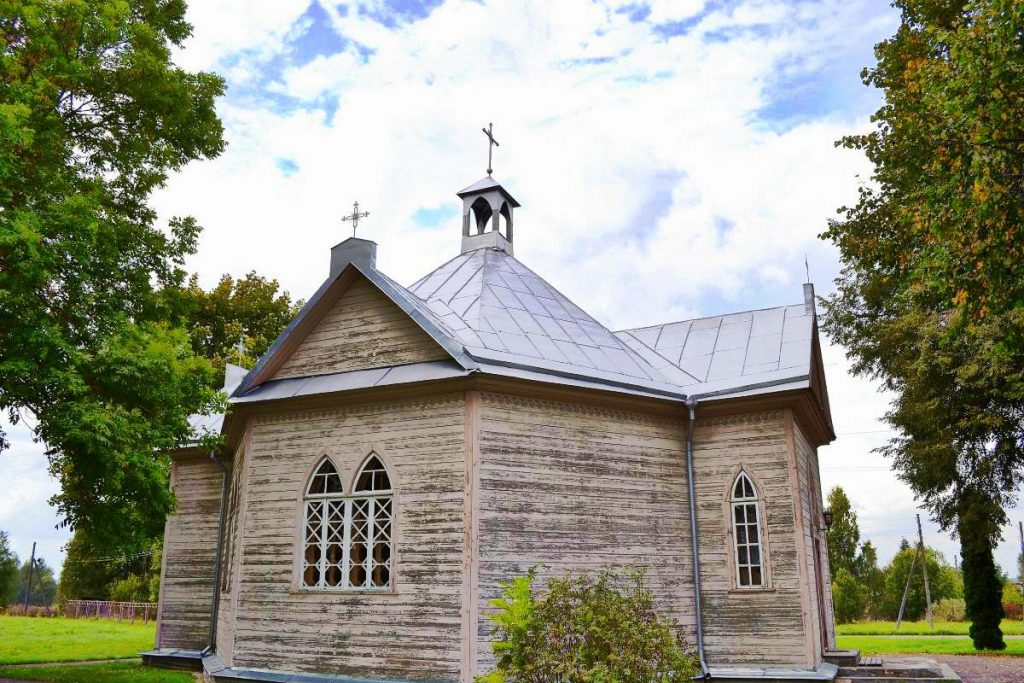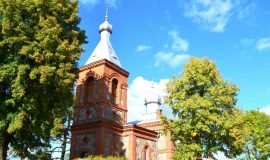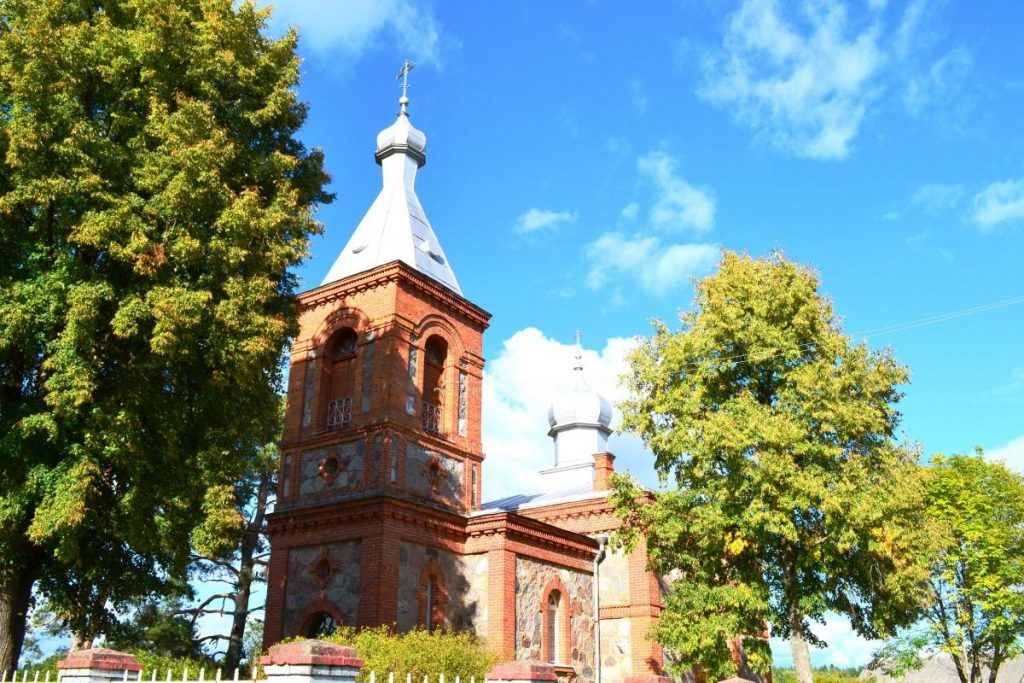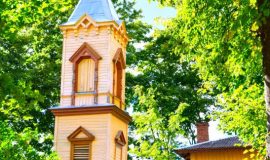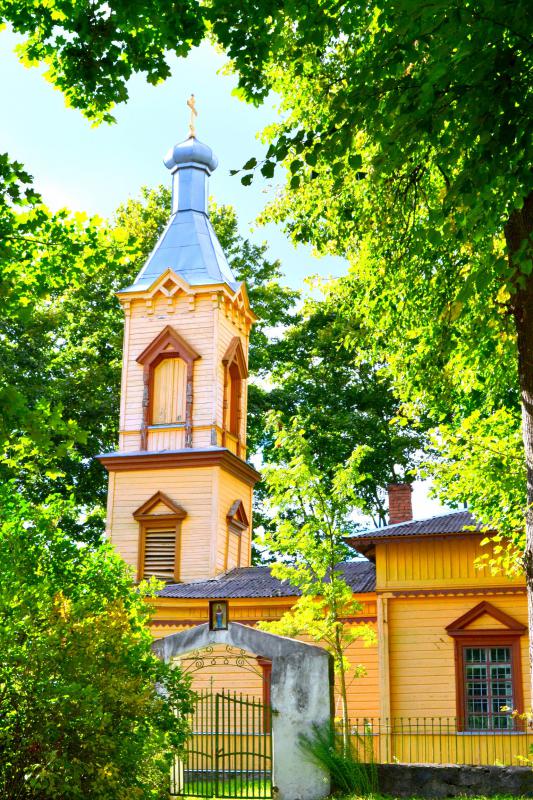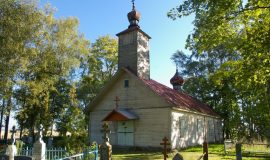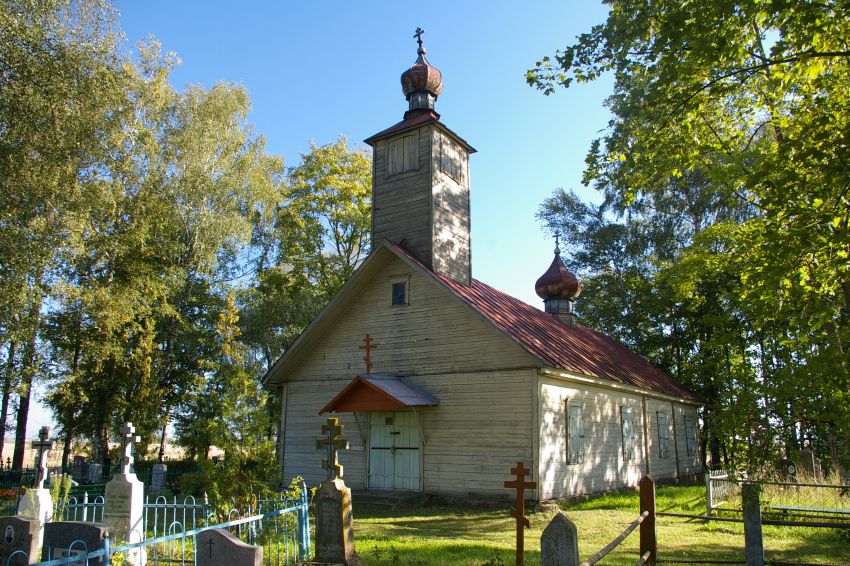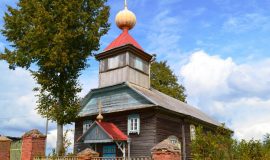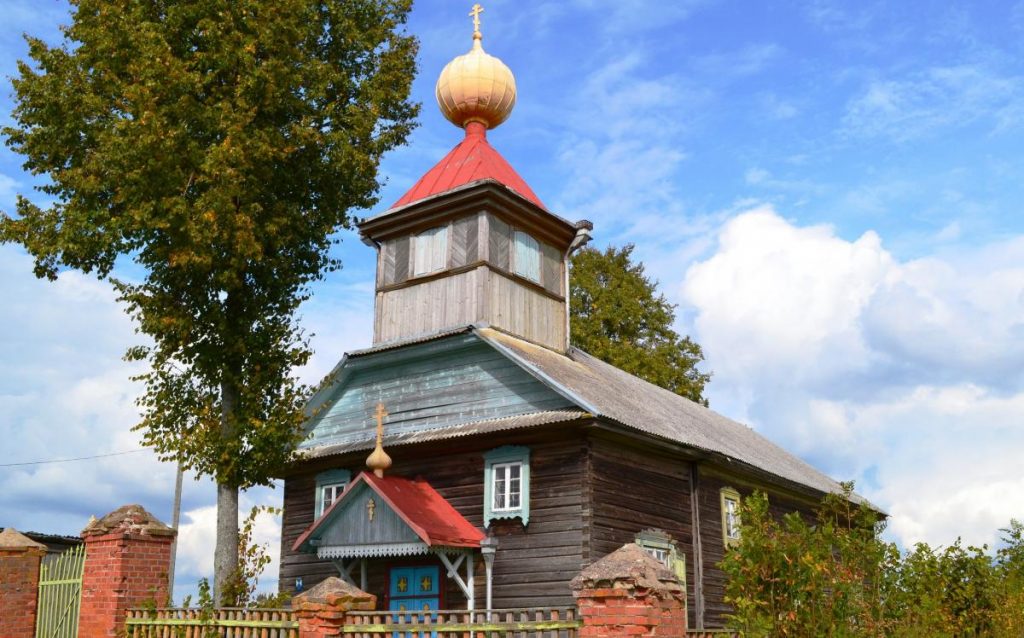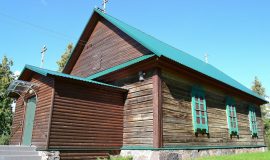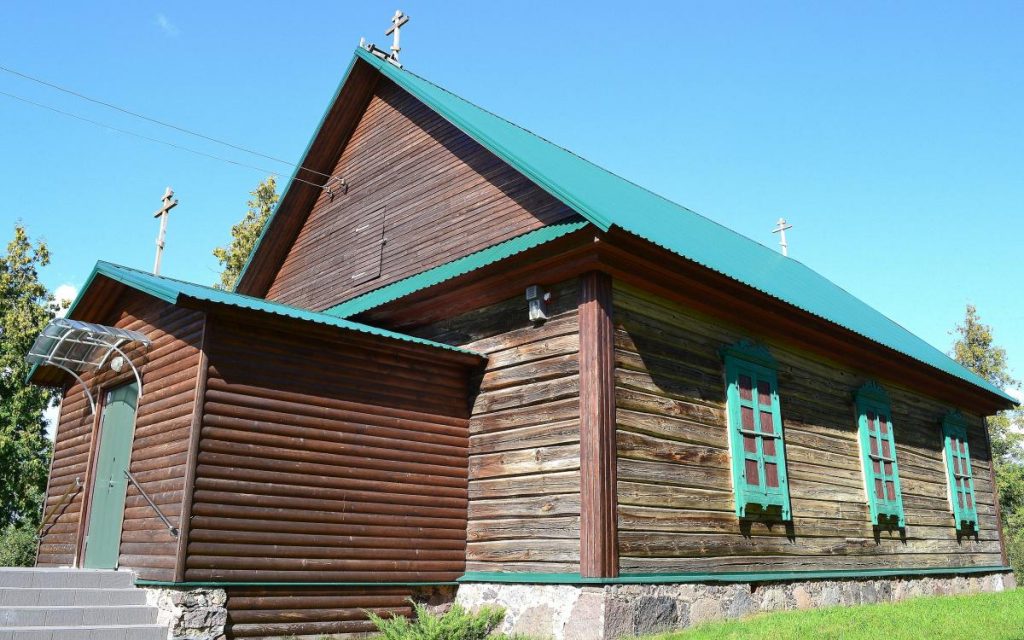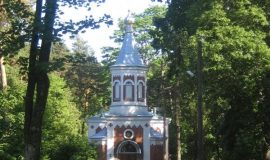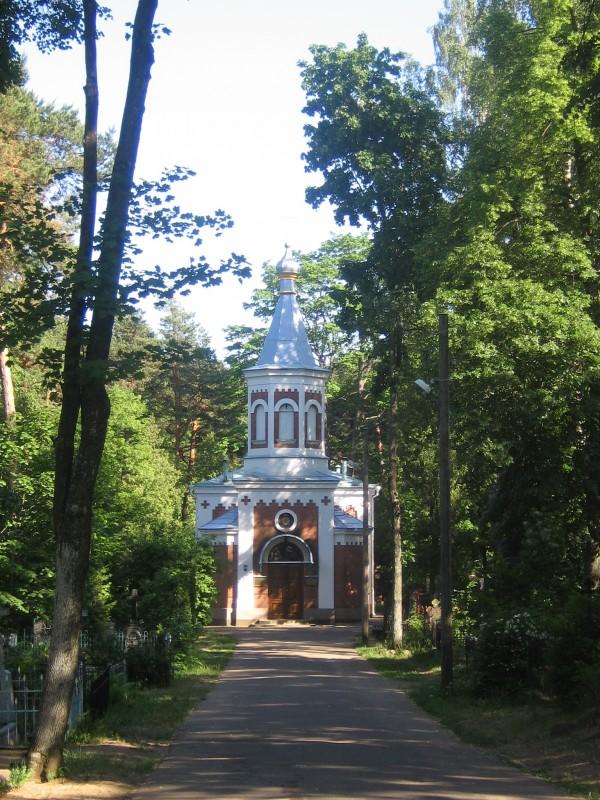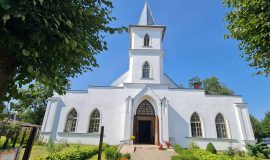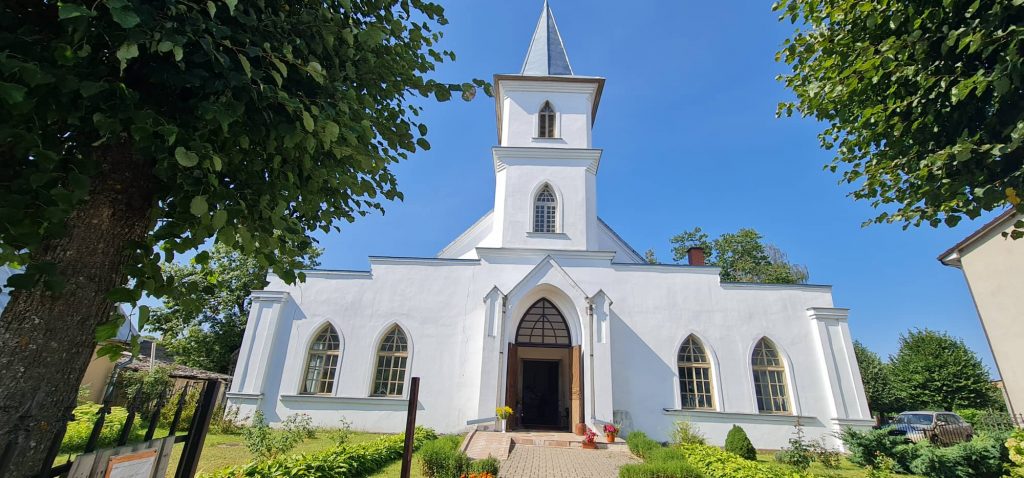Every traveller who wants to be acquainted with Daugavpils should definitely visit the Church Hill that has gathered the churches of four different confessions – Martin Luther Cathedral, Roman Catholic Church of the Blessed Virgin Mary, SS Boris and Gleb Russian Orthodox Cathedral and Church of the Community of Old Believers.
Sacral heritage
St. Boriss & Gleb Russian Orthodox Cathedral in Daugavpils
St.Boris and Gleb Orthodox Cathedral was built in 1904-1905 and was consecrated on 12 June 1905. t.Boris and Gleb Cathedral in the sense of the use of numerous decorative elements is recognized as the most gorgeous orthodox cathedral of this region. Its building is justly considered as one of the most spacious, richly decorated and arranged orthodox cathedrals not only in Latgale, but also in whole Latvia.
Daugavpils Martin Luther Cathedral
Martin Luther Cathedral designed by V. Neimanis was built in 1893. The church was made in Neogothic style. It has an asymmetrical planning and one tower. The building was constructed of red bricks.
Viewing platform of Martin Luther Cathedral
The tower stands at a height of 5 houses, and the observation deck is located at a height of about 40 m. It offers panorama of the Church hill.
Daugavpils Roman Catholic Church of the Blessed Virgin Mary
Daugavpils Roman Catholic Church of the Blessed Virgin Mary was built in 1905. The church facade with two towers together with the ordently towers is made in the Neobaroque forms, and the Historicist interiors are augmented by a copy of Bartolome Estebam Murillo’s “Immaculate Conception”.
Old Believers’ Church of Resurrection, Birth of Mother of God and St. Nicholas in Jaunbuve
Daugavpils first Old Believers’ church is one of the biggest in the whole Latvia. The church was consecrated in 1928 in honor of the birth of Mother of God and St. Nicholas.
Roman Catholic Church of the Sacred Heart of Jesus in Liksna
Liksna Church was build in Neo-Gothic style. The building of Catholic Church in Liksna was finished in 1913. Churchs silhouette is the most important landscape dominant of Daugava valley in environs of Kosa Lake.
Daugavpils Synagogue
Daugavpils synagogue Kadish built in 1850 is located at 38 Cietoksna Street. The Jewish of Daugavpils and Latgale museum is located on the 2nd floor of the synagogue.
Roman Catholic Church of St. John the Baptist in Viski
Catholic Church in Viski was built in period 1908 – 1925. It is significant national landmark, one of the few sacral buildings in Daugavpils region that was built of abated stones and belongs to one-tower basilica crucifix church type.
St. Peter’s in Chains Roman Catholic Church
Saint Peter’s in Chains Roman Catholic Church is built in 1848–1849, rebuilt in 1924–1934. It has some resemblance to Saint Peter’s Basilica in Vatican.
The Centre of Russian Culture (Russian House)
The Centre of Russian Culture offers unique expositions: Old Believers in Latvia, The Orthodox in Latvia, Pictures by Pyotr Khudobchenok, Gzhel Ceramics, Khokhloma Ware, Dinaburg Fortress in the War 1812.
Assumption of the Blessed Virgin Mary Orthodox Church in Lipiniski
The church was built in 1906 and was consecrated in 1908. The church was constructed in the form of a cross in Byzantine style and is made of red bricks and has two towers. There are a lot of decorative elements in the facade design.
St. Peter and Paul Roman Catholic Church in Jezupova (Juzefova)
The building of Jezupova (Juzefova) St. Peter and Paul Roman Catholic Church was started in 1934 and was finished in 1961. After the building was finished the church was taken from the parish and there was established club. In 1989 the church was returned to the parish.
Zemgale Catholic Church
It was consecrated in 2006. The church is located in the building of the previous estate and in Zemgale station building (1928).
Silene Roman Catholic Church of the Assumption of the Blessed Virgin Mary
Present-day wooden building of Silene Roman Catholic Church was built in 1913, not far from the burnt down chapel that was built in 19th century. Silene Church is one of the largest wooden churches in Riga’s Metropolis.
Maskovska’s (Moscow) St. Virgin Shelter Orthodox Church
Built and consecrated in 1879. The church’s altar is simple, without ornamentation. Especially expressive is church gates built in Novgorod style and several ancient icons.
Orthodox Church of St.Peter and Paul in Danisevka
Church is located in a picturesque place Daniševka, near the Lake Lukna. The building was built and consecrated on August 31, 1908. There is a grave of the first pastor of this church – I. Digilev (1869-1933) in the church garden.
Holy Cross Roman Catholic Church in Jaunborne
Built in 1859 at will of Polish landlord Julius Sivickis. It was rebuilt in 1890 and renewed in 1921. There is a cemetery around the church, where are burials of Sivickis family.
Elerne Ascension of Lord Jesus Roman Catholic Church
The building of the Elernes Church was constructed in 1650 by Heinrich Tienen. Until 1761 it served the needs of the Lutheran Church, but later the Lutherans exchanged with Catholics with the Sīkele Church. The architecture of the church, in both volume and details, is in correspondence with other churches that were built in the territory of the Courland Duchy of that time.
Sikele Lutheran Church
It was built in 1819. At first the church belonged to the Catholic community, but it was given back to Lutherans instead of Elerne church in the second half of the 18th century.
Crucifix Way
The largest number of crucifixes in Latvia is located on the territory of the Vabole parish. After the Second World War, many were destroyed – from 44 crucifixes only 29 remained.
Forstate Heart of Jesus Roman Catholic Church
The church in the urban landscape is distinguished by its pointed tower made in the Gothic style and by light finishing of the facade. In addition, this project combines classical and modern, as the temple of God is located near the cultural and historic wooden building which is typical for Daugavpils.
Grīva Roman Catholic Church of the Holy Mary
Grīva Roman Catholic Church of the Holy Mary was built in 1881 – 1889 and altered in 1935 – 1942. Next to, it a bell tower was built in 1990 (arhitect: Kazimirs Lielausis). Grīva Church is a brick building with Romanesque and Gothic elements in the facade decoration. The most important interior features are the 3 stained glass windows with figural scenes, made at the St. Lucas Workshop in Warshaw in 1889. The pipe organ made at the Krustpils workshop of Friedrich Weissenborn in 1890.
St. Alexander Nevsky Orthodox Church in Daugavpils
The church was consecrated in 1897. The church is a one-story wooden log building that is not covered with boards. The pointed towers with four-sided roof are located above the side entrances on the roofs. The part of the altar roof is decorated with a tower, which hexagonal volume supports the cupola with a cross in the form of an onion.
St. Nichola’s Russian Orthodox Church in Daugavpils
St. Nichola’s Russian Orthodox Church in Daugavpils was built in 1894 and is located near graves. It is built of red bricks; the decorative masonry bands are made in the corners of the building, above the footings and under the roof cornices.
Daugavpils St. Peter and Paul Russian Orthodox Church
Daugavpils St. Peter and Paul Russian Orthodox Church has two towers: a bell tower above the entrance and smaller tower at the east end. The icons date from 1833 up to the earl 20th century, one group of them brought from Moscow.
Dormition Orthodox Church
Dormition Orthodox church was consecrated in 1877. In 1964 The Soviets closed it. Until 1991 there was a library in the church building. In 2007 the first divine service took place in the renovated church.
St. Nicholas Russian Orthodox Church in Griva
St. Nicholas Russian Orthodox Church in Griva was consecrated in 1924. The wooden carvings are the characteristic feature of the church.
Old-believer’s Prayer House in Gajok
Old-believer’s Prayer House of The Annunciation of the Most Holy Mother of God and Nicholas the Wonderwoker in Gajok. Old-believer’s Prayer House in Gajok was consecrated on March 30 in 1886. The church was one of the most beautiful religious buildings in Daugavpils. The hand of a professional is clearly seen in the architectural shapes of the church.
Old Believer’s Prayer House in Griva
The temple was built in the 30s of the 20th century.
Old-believer’s Prayer House in Niderkuni
Old-believer’s Prayer House in Niderkuni was built in 1907, but in 1908 – 1911 work on the interior design was carried out. The parishioners presented icons and books to the new church. The icons painted by Konstantin Pavlov, Vasilij Kirillin, Barbara Kirillina and Leontij Seleznev have remained in the iconostasis till nowadays.
Memorial Place of the 1st Baltic Old-believers Prayer House (1660)
In Daugavpils, at the cross point of Baznicas and Liginisku streets, the memorial place of the first Baltic Old Believer’s prayer house (1660) is located.
Old-believer’s Chapel in Panteliski (Briveri)
The chapel was built in the late 19th century. It was made of logs and is covered with horizontal boards. There is a high bell tower covered with the unusual four-sided roof. The windows are decorated with jamb, which is ornamented with woodcuts.
Lutheran Church in Demene
The church was built in 1895–1896. The project author is the architect Wilhelm Neumann. The church is a small, one-volume hall-type building with one-tower facade. The building has a gable roof. Now, the building is laid up and is not used.
St. Alexander Nevsky Russian Orthodox Chapel
St. Alexander Nevsky Russian Orthodox Chapel was consecrated in 2004. Located in A. Pumpurs public garden (20 Saules Street) on the former site of St. Alexander Nevsky Cathedral (1864–1961). The chapel is a memorial structure that has a symbolic meaning, serving as a reminder of the demolished cathedral.
Jaunborne chapel (crucifix)
There is a bricks chapel in Jaunborne, with a niche, in which there is the Virgin Mary’s permanent assistant painting in a wooden frame.
St. George Roman Catholic Church in Ambeli
Catholic church in Ambeļi displays typical use of local traditions of wood-building of 18th-19th centuries in sacral architecture, its structure represents work of professional painting and sculpture experts of baroque period.
St. Ilija Orthodox Church in Malinova
The current St. Ilija Orthodox Church in Malinova is a rebuilt priest’s house. In 2010, the Culture House, located on the site of the former church, was burned down, now on this site new Orthodox Church is being restored.
Old Believers Chapel in Rubeniski
The chapel is build in 1907. Chapel has repeatedly lost its sacred meaning, but since 2003, the it has been repaired with the help of renewed parish. Local residents and Old Believer communities of Latvia help the church.
Blessed Jesus’ Heart Roman Catholic Church in Demene
The construction of the Demene Church was started in 1932, but the Second World War stopped this plans. During the Soviet times here was a place of entertainment. Sacral meaning this building regained in the 80’s, but fully completed and consecrated in Church was only in 1992.
Old-believer’s Chapel in Bondariski
Old-believer’s Chapel in Bondariski was built between 1920 and 1930. The volume composition of the building is very simple: a single volume with a gable roof, a rectangular bell tower that “grows” from the roof and is covered with four-sided tent. The building is preserved in the authentic form.
Krivosejeva Old Believers Chapel
Krivosejeva Old Believers Chapel is built in the beginning of the 20th century, around 1906. The roof was erected in 1926. The chapel are built in the log house technique and clad with horizontally painted boards. Alongside the temple there is an Old Believers’ Cemetery, where you can see ancient unique grave monuments – steles.
Old-believer’s Chapel in Ascuki
The present chapel was built in 1910 at the place of the former chapel. After the Direktive “On Toleration” in 1905, Old Believers were allowed to build religious buildings and to build up their cemeteries.
Protection of the Holy Virgin Chapel in Danisevka
The chapel that has been preserved till nowadays, probably was built after 1905. The only decorative accent is a small diamond-shaped window over the entrance. The common image of the chapel has been created thanks to the precisely found proportions of shapes.
St. Peter and Paul Roman Catholic Church in Laucese
Catholic Church is wooden building built in period from 1921 till 1923 in place of old wooden church (1797), which burnt down in 1920. This was one of the oldest churches in Zemgale owned by landlords Ludvinghauzens-Volfs.
Berkenele (Birkeneli) Lutheran Church
Church building (1830) was built for Friedrich von Klopmann’s funds. The tower’s peak is decorated with an ornamental windshield, but the church has not been functioning for many decades since the Soviets have seized it.
Egypt’s Lutheran Parish Church
The church was built in Vilkumiests by landlord A.Oettingen in 1823. In 1863 the church’s tower was built. During World War I it was destroyed, and during World War II – absolutely vandalized.
St.Virgin Mary’s Roman Catholic Church in Nicgale
Stone building of the church was built in the Neo-Gothic style by order from Count Henrih Plater-Zyberk in 1863.
St.Family’s Roman Catholic Church in Aukskalne
Church is 18.5m long and 8.5m wide wooden building covered with bricks. Church was consecrated in 1947. Previous church burnt down in 1944, and most of building materials for the new church was donated by parish members.
Holy Virgin’s Old Believer Chapel in Voitiski
The Old Believer community in the village of Voitiski was founded in 1740. The first chapel was a wooden blockhouse, without a footing, with a straw roof. Срapel suffered from fires several times, so in 1979 it was decided to build a stone chapel.
Russian Orthodox Church of George the Victorious in Januciems (Fabijanova)
It was build thanks to August Pfug project and was consecrated in 1878. The building is made of chipped stones with a filling of a splinter. The corners and the edges of the church are made of red bricks, produced in the Kalkuni brick factory.
Kalupe Sacrament Roman Catholic Church of the Holy Altar
The church was built from red bricks in the period from 1861 to 1882. It has cross-shaped form without towers.
St. Michael’s Archangel Roman Catholic Church in Svente
In 1800 landlord Casimir Plater-Zyberk in Svente built stone church in honor of the Trinity. Sacral building was consecrated in honor of Michael Archangel.
St. Anthony’s Roman Catholic Church in Sprukti
St. Anthony’s Roman Catholic Church in Sprukti was built of cement bricks at the expenses of the parish and the bishop in 1933 – 1938.
Medumi St. John the Baptist Roman Catholic Church
The church was built in the period from 1933 till 1935 according to the project of architect Pavlov under the supervision of J. Klonis at the expenses of the parish.
Jesus’ Heart Catholic Chapel in Dubna (Varsavena)
Chapel was built in 1800 as a wooden octagonal building with an extension of the altar part. This is the only sacred building of this type in the Daugavpils district.
St. John the Baptist Orthodox Church in Saliena (Tartaks)
Saliena Church was built in 1894 from abated rocks and it had brick lining inside. Church was consecrated in 1895.
Skrudaliena Orthodox Church of the Assumption of the Blessed Virgin Mary
In 1862 in Skrudaliena was built new wooden church that became the parish church in 1872, as a new belfry and cupola, as well as an iron roof was built up.
Old-believer’s Chapel in Korolevscina
Chapel was built in 1918. Later it was rebuilt – as a result new forms are similar to the motifs of the Protestant churches, and they were probably borrowed from the surrounding cultural environment in Latgale and testify the process of the mutual influence between the two cultures.
Old-believer’s Chapel in Krivani
The Chapel was built in the 20th century. The building has one tower and several windows of different sizes with decorative shutters.
Old Believer’s Chapel in Medumi
The available sources indicate different dates of the prayer house building – in the range from the early 20th century until 1940. The chapel is interesting because it gives the idea of how the religious building of Old Believers looked till 1905, at that time, when they were not allowed to give a recognizable form to their churches.
St.Nichola’s Russian Orthodox Church in Daugavpils
It was built in 1894 and is located near graves. It is built of red bricks; the decorative masonry bands are made in the corners of the building, above the footings and under the roof cornices. A semi-circular-shaped sheet metal roof is constructed above the entrance door, where there is also a small round window with St. Nicholas painting in the center of it.
Ilukste Lutheran church
The beginnings of the Ilukste Lutheran church can be traced back to the 16th century. Selonia was a Lutheran land at that time.


